Energy Geography - Industrial Revolution
VerifiedAdded on 2022/08/18
|24
|7229
|16
AI Summary
Contribute Materials
Your contribution can guide someone’s learning journey. Share your
documents today.
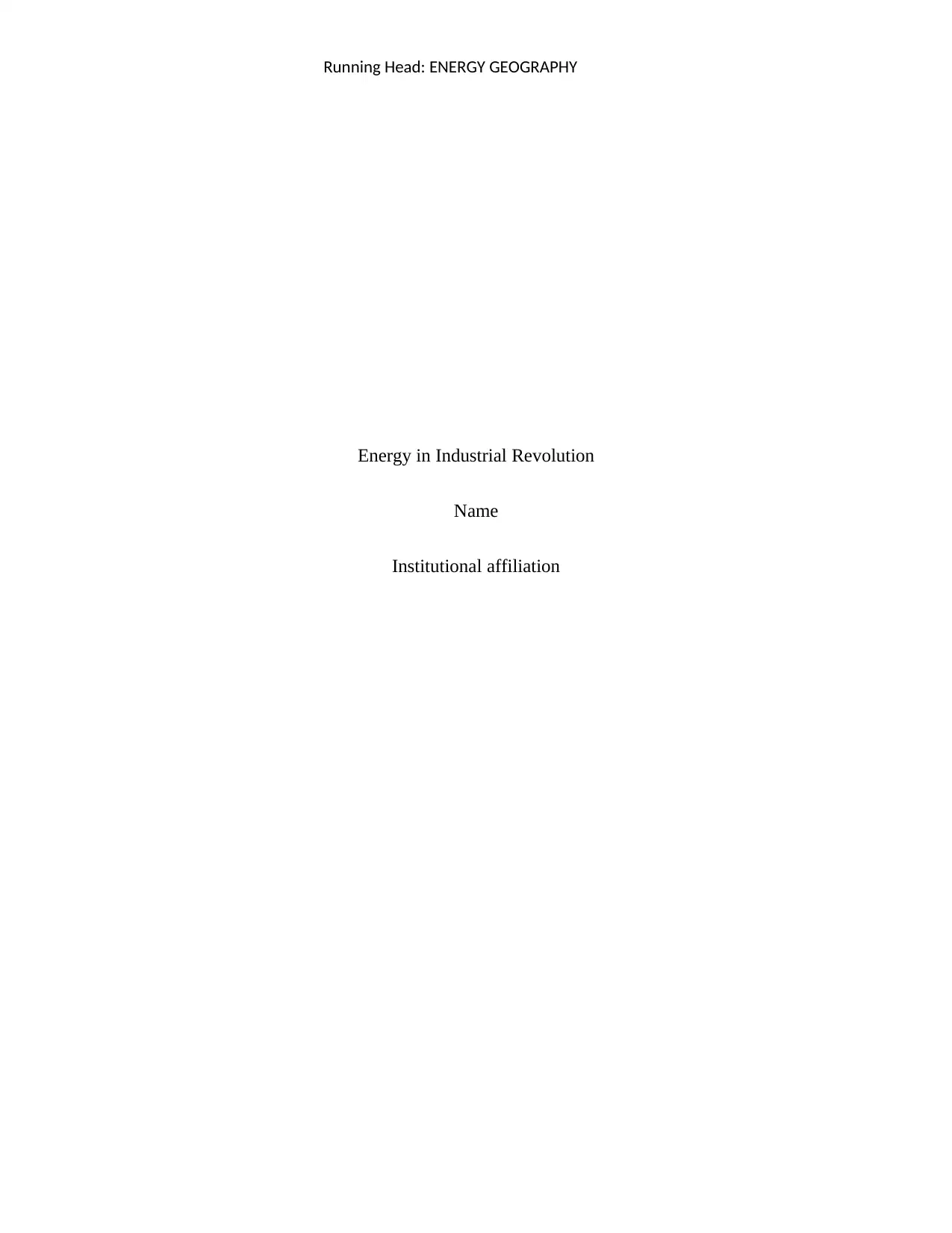
Running Head: ENERGY GEOGRAPHY
Energy in Industrial Revolution
Name
Institutional affiliation
Energy in Industrial Revolution
Name
Institutional affiliation
Secure Best Marks with AI Grader
Need help grading? Try our AI Grader for instant feedback on your assignments.
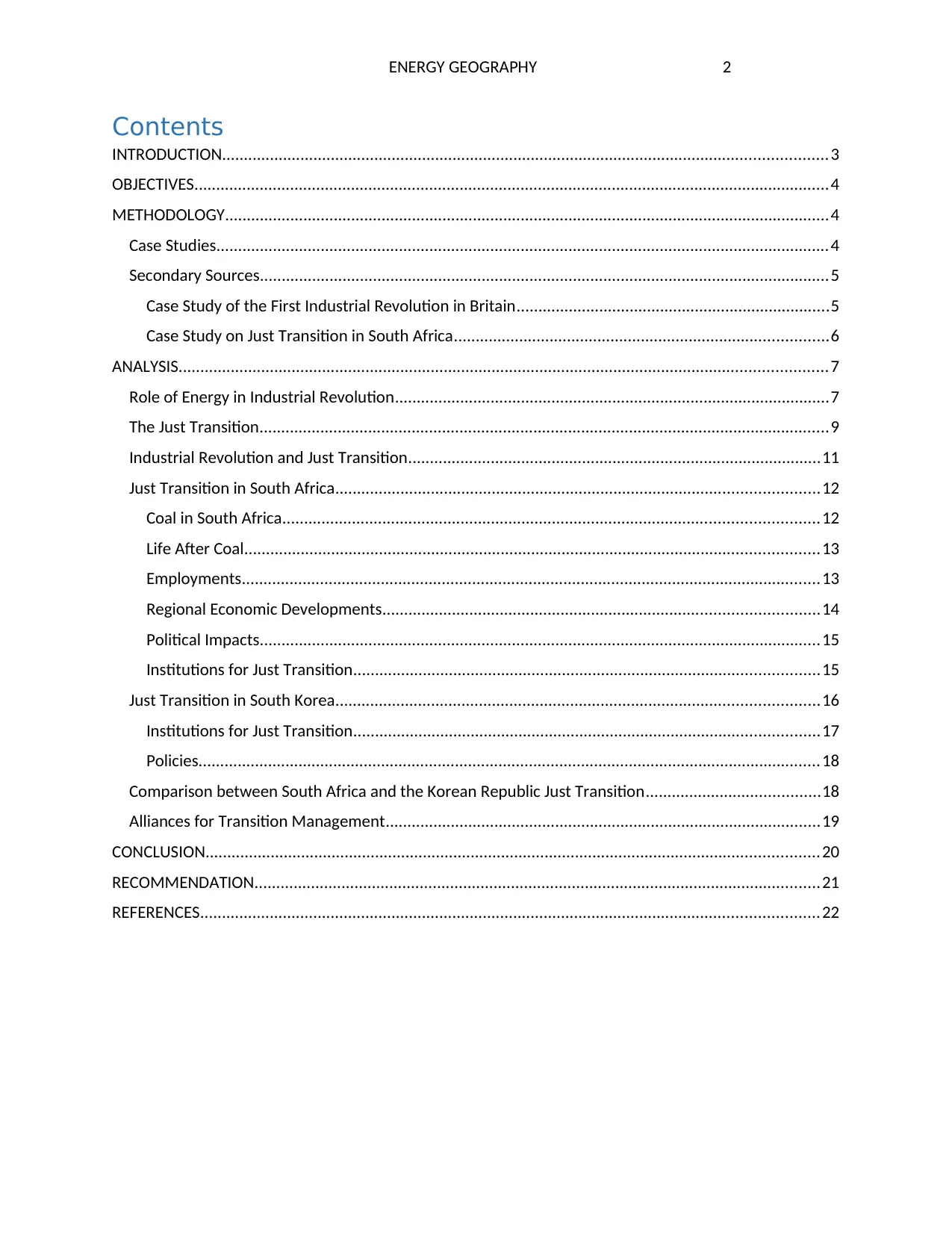
ENERGY GEOGRAPHY 2
Contents
INTRODUCTION...........................................................................................................................................3
OBJECTIVES..................................................................................................................................................4
METHODOLOGY...........................................................................................................................................4
Case Studies.............................................................................................................................................4
Secondary Sources...................................................................................................................................5
Case Study of the First Industrial Revolution in Britain........................................................................5
Case Study on Just Transition in South Africa......................................................................................6
ANALYSIS.....................................................................................................................................................7
Role of Energy in Industrial Revolution....................................................................................................7
The Just Transition...................................................................................................................................9
Industrial Revolution and Just Transition...............................................................................................11
Just Transition in South Africa...............................................................................................................12
Coal in South Africa...........................................................................................................................12
Life After Coal....................................................................................................................................13
Employments.....................................................................................................................................13
Regional Economic Developments....................................................................................................14
Political Impacts.................................................................................................................................15
Institutions for Just Transition...........................................................................................................15
Just Transition in South Korea...............................................................................................................16
Institutions for Just Transition...........................................................................................................17
Policies...............................................................................................................................................18
Comparison between South Africa and the Korean Republic Just Transition........................................18
Alliances for Transition Management....................................................................................................19
CONCLUSION.............................................................................................................................................20
RECOMMENDATION..................................................................................................................................21
REFERENCES..............................................................................................................................................22
Contents
INTRODUCTION...........................................................................................................................................3
OBJECTIVES..................................................................................................................................................4
METHODOLOGY...........................................................................................................................................4
Case Studies.............................................................................................................................................4
Secondary Sources...................................................................................................................................5
Case Study of the First Industrial Revolution in Britain........................................................................5
Case Study on Just Transition in South Africa......................................................................................6
ANALYSIS.....................................................................................................................................................7
Role of Energy in Industrial Revolution....................................................................................................7
The Just Transition...................................................................................................................................9
Industrial Revolution and Just Transition...............................................................................................11
Just Transition in South Africa...............................................................................................................12
Coal in South Africa...........................................................................................................................12
Life After Coal....................................................................................................................................13
Employments.....................................................................................................................................13
Regional Economic Developments....................................................................................................14
Political Impacts.................................................................................................................................15
Institutions for Just Transition...........................................................................................................15
Just Transition in South Korea...............................................................................................................16
Institutions for Just Transition...........................................................................................................17
Policies...............................................................................................................................................18
Comparison between South Africa and the Korean Republic Just Transition........................................18
Alliances for Transition Management....................................................................................................19
CONCLUSION.............................................................................................................................................20
RECOMMENDATION..................................................................................................................................21
REFERENCES..............................................................................................................................................22
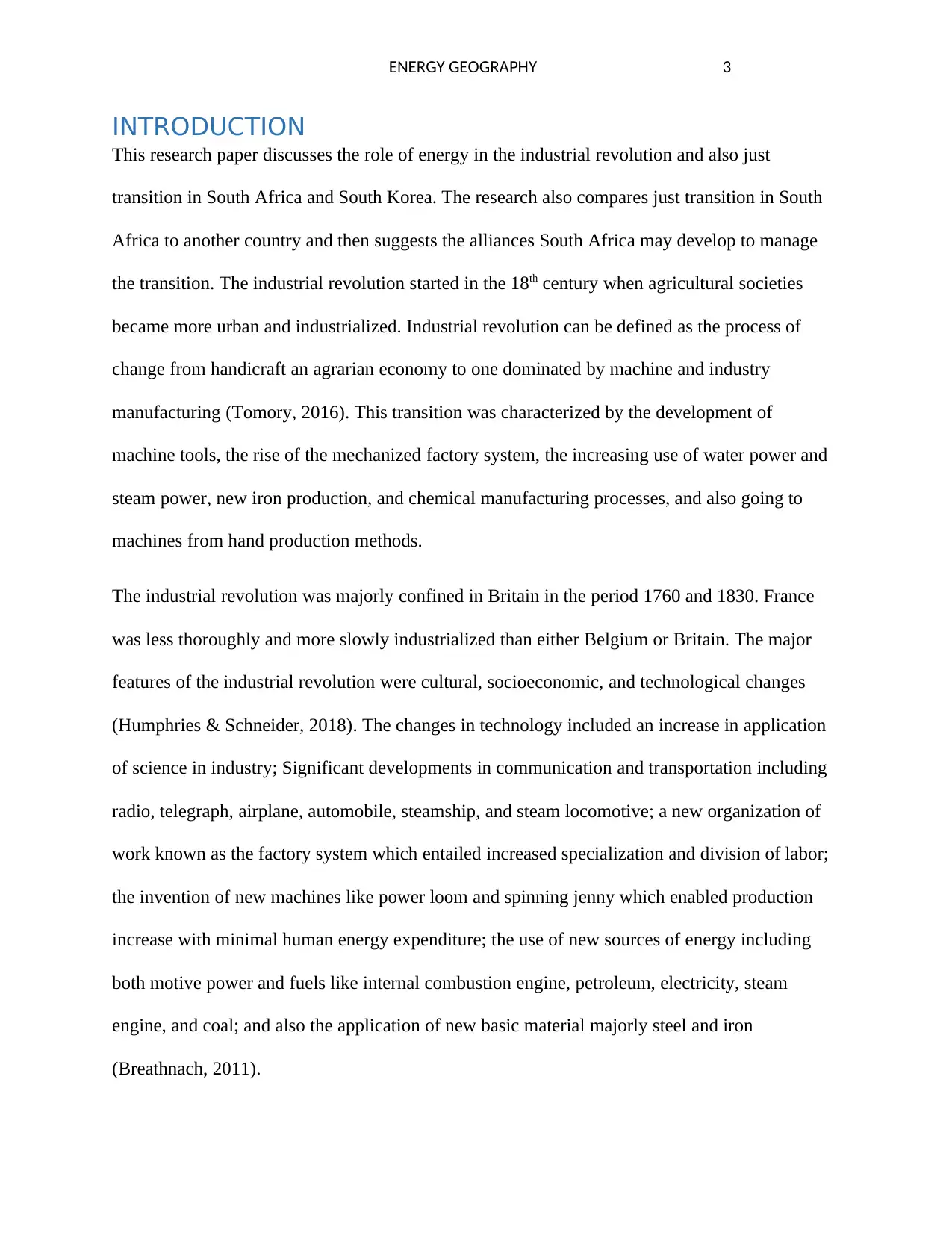
ENERGY GEOGRAPHY 3
INTRODUCTION
This research paper discusses the role of energy in the industrial revolution and also just
transition in South Africa and South Korea. The research also compares just transition in South
Africa to another country and then suggests the alliances South Africa may develop to manage
the transition. The industrial revolution started in the 18th century when agricultural societies
became more urban and industrialized. Industrial revolution can be defined as the process of
change from handicraft an agrarian economy to one dominated by machine and industry
manufacturing (Tomory, 2016). This transition was characterized by the development of
machine tools, the rise of the mechanized factory system, the increasing use of water power and
steam power, new iron production, and chemical manufacturing processes, and also going to
machines from hand production methods.
The industrial revolution was majorly confined in Britain in the period 1760 and 1830. France
was less thoroughly and more slowly industrialized than either Belgium or Britain. The major
features of the industrial revolution were cultural, socioeconomic, and technological changes
(Humphries & Schneider, 2018). The changes in technology included an increase in application
of science in industry; Significant developments in communication and transportation including
radio, telegraph, airplane, automobile, steamship, and steam locomotive; a new organization of
work known as the factory system which entailed increased specialization and division of labor;
the invention of new machines like power loom and spinning jenny which enabled production
increase with minimal human energy expenditure; the use of new sources of energy including
both motive power and fuels like internal combustion engine, petroleum, electricity, steam
engine, and coal; and also the application of new basic material majorly steel and iron
(Breathnach, 2011).
INTRODUCTION
This research paper discusses the role of energy in the industrial revolution and also just
transition in South Africa and South Korea. The research also compares just transition in South
Africa to another country and then suggests the alliances South Africa may develop to manage
the transition. The industrial revolution started in the 18th century when agricultural societies
became more urban and industrialized. Industrial revolution can be defined as the process of
change from handicraft an agrarian economy to one dominated by machine and industry
manufacturing (Tomory, 2016). This transition was characterized by the development of
machine tools, the rise of the mechanized factory system, the increasing use of water power and
steam power, new iron production, and chemical manufacturing processes, and also going to
machines from hand production methods.
The industrial revolution was majorly confined in Britain in the period 1760 and 1830. France
was less thoroughly and more slowly industrialized than either Belgium or Britain. The major
features of the industrial revolution were cultural, socioeconomic, and technological changes
(Humphries & Schneider, 2018). The changes in technology included an increase in application
of science in industry; Significant developments in communication and transportation including
radio, telegraph, airplane, automobile, steamship, and steam locomotive; a new organization of
work known as the factory system which entailed increased specialization and division of labor;
the invention of new machines like power loom and spinning jenny which enabled production
increase with minimal human energy expenditure; the use of new sources of energy including
both motive power and fuels like internal combustion engine, petroleum, electricity, steam
engine, and coal; and also the application of new basic material majorly steel and iron
(Breathnach, 2011).
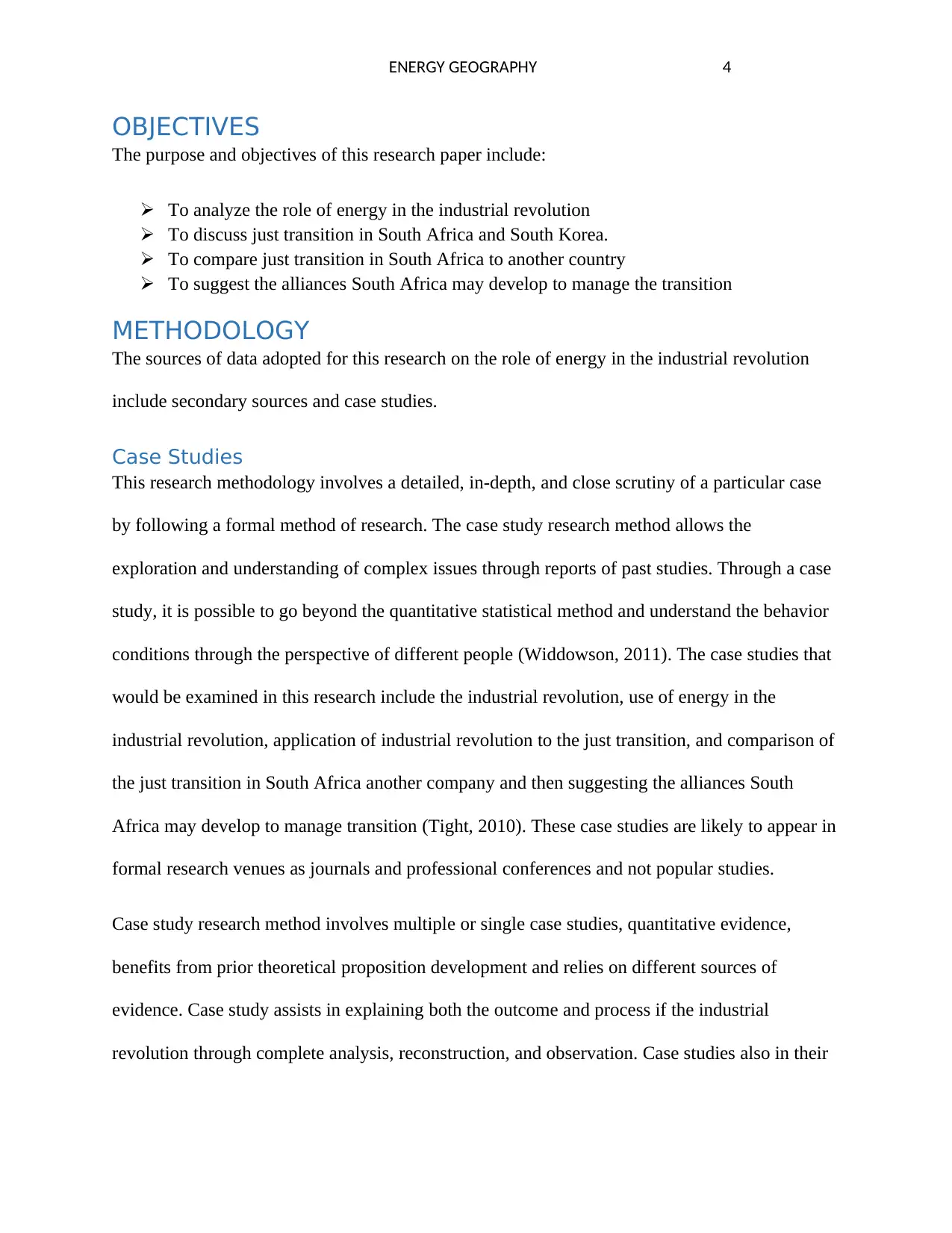
ENERGY GEOGRAPHY 4
OBJECTIVES
The purpose and objectives of this research paper include:
To analyze the role of energy in the industrial revolution
To discuss just transition in South Africa and South Korea.
To compare just transition in South Africa to another country
To suggest the alliances South Africa may develop to manage the transition
METHODOLOGY
The sources of data adopted for this research on the role of energy in the industrial revolution
include secondary sources and case studies.
Case Studies
This research methodology involves a detailed, in-depth, and close scrutiny of a particular case
by following a formal method of research. The case study research method allows the
exploration and understanding of complex issues through reports of past studies. Through a case
study, it is possible to go beyond the quantitative statistical method and understand the behavior
conditions through the perspective of different people (Widdowson, 2011). The case studies that
would be examined in this research include the industrial revolution, use of energy in the
industrial revolution, application of industrial revolution to the just transition, and comparison of
the just transition in South Africa another company and then suggesting the alliances South
Africa may develop to manage transition (Tight, 2010). These case studies are likely to appear in
formal research venues as journals and professional conferences and not popular studies.
Case study research method involves multiple or single case studies, quantitative evidence,
benefits from prior theoretical proposition development and relies on different sources of
evidence. Case study assists in explaining both the outcome and process if the industrial
revolution through complete analysis, reconstruction, and observation. Case studies also in their
OBJECTIVES
The purpose and objectives of this research paper include:
To analyze the role of energy in the industrial revolution
To discuss just transition in South Africa and South Korea.
To compare just transition in South Africa to another country
To suggest the alliances South Africa may develop to manage the transition
METHODOLOGY
The sources of data adopted for this research on the role of energy in the industrial revolution
include secondary sources and case studies.
Case Studies
This research methodology involves a detailed, in-depth, and close scrutiny of a particular case
by following a formal method of research. The case study research method allows the
exploration and understanding of complex issues through reports of past studies. Through a case
study, it is possible to go beyond the quantitative statistical method and understand the behavior
conditions through the perspective of different people (Widdowson, 2011). The case studies that
would be examined in this research include the industrial revolution, use of energy in the
industrial revolution, application of industrial revolution to the just transition, and comparison of
the just transition in South Africa another company and then suggesting the alliances South
Africa may develop to manage transition (Tight, 2010). These case studies are likely to appear in
formal research venues as journals and professional conferences and not popular studies.
Case study research method involves multiple or single case studies, quantitative evidence,
benefits from prior theoretical proposition development and relies on different sources of
evidence. Case study assists in explaining both the outcome and process if the industrial
revolution through complete analysis, reconstruction, and observation. Case studies also in their
Secure Best Marks with AI Grader
Need help grading? Try our AI Grader for instant feedback on your assignments.
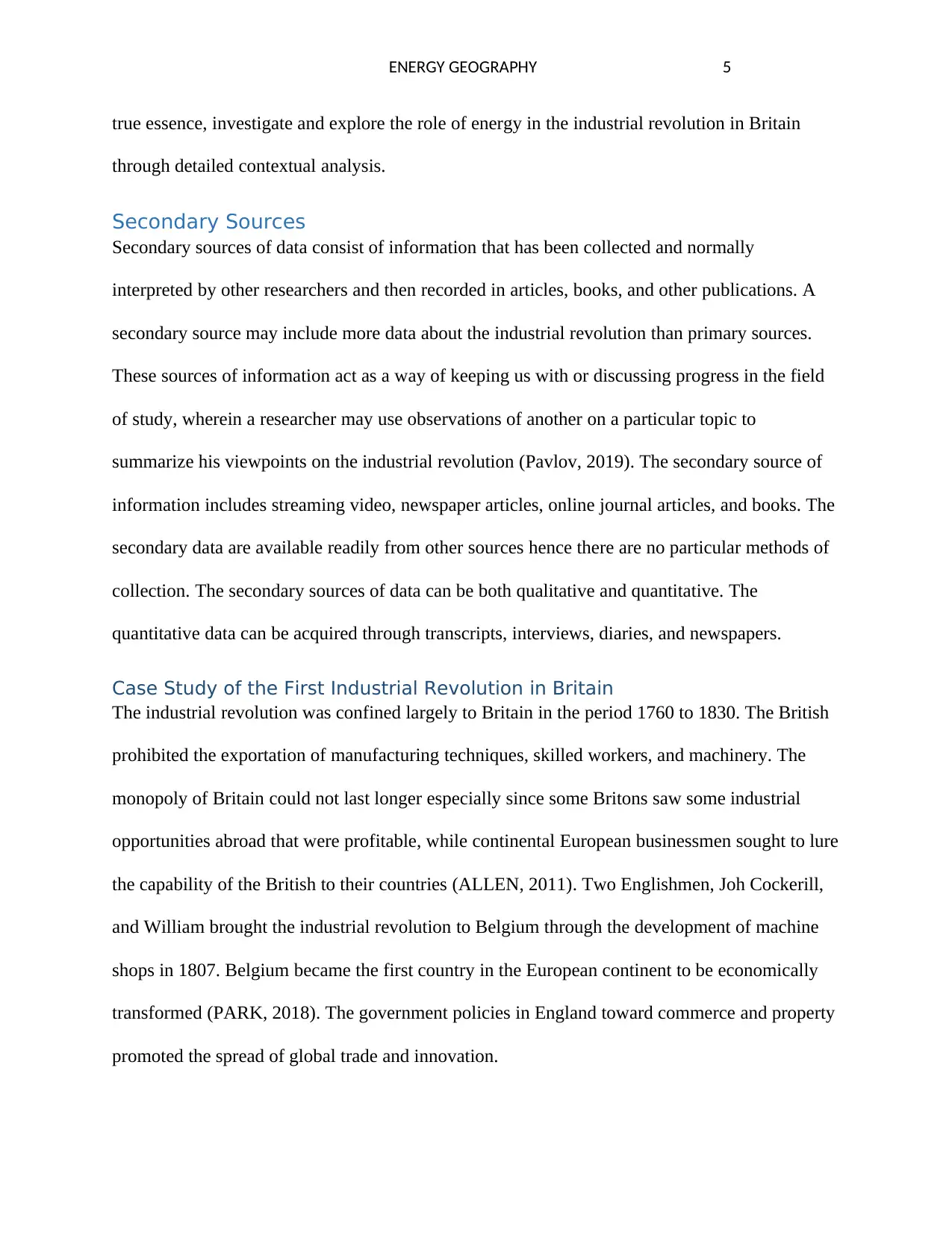
ENERGY GEOGRAPHY 5
true essence, investigate and explore the role of energy in the industrial revolution in Britain
through detailed contextual analysis.
Secondary Sources
Secondary sources of data consist of information that has been collected and normally
interpreted by other researchers and then recorded in articles, books, and other publications. A
secondary source may include more data about the industrial revolution than primary sources.
These sources of information act as a way of keeping us with or discussing progress in the field
of study, wherein a researcher may use observations of another on a particular topic to
summarize his viewpoints on the industrial revolution (Pavlov, 2019). The secondary source of
information includes streaming video, newspaper articles, online journal articles, and books. The
secondary data are available readily from other sources hence there are no particular methods of
collection. The secondary sources of data can be both qualitative and quantitative. The
quantitative data can be acquired through transcripts, interviews, diaries, and newspapers.
Case Study of the First Industrial Revolution in Britain
The industrial revolution was confined largely to Britain in the period 1760 to 1830. The British
prohibited the exportation of manufacturing techniques, skilled workers, and machinery. The
monopoly of Britain could not last longer especially since some Britons saw some industrial
opportunities abroad that were profitable, while continental European businessmen sought to lure
the capability of the British to their countries (ALLEN, 2011). Two Englishmen, Joh Cockerill,
and William brought the industrial revolution to Belgium through the development of machine
shops in 1807. Belgium became the first country in the European continent to be economically
transformed (PARK, 2018). The government policies in England toward commerce and property
promoted the spread of global trade and innovation.
true essence, investigate and explore the role of energy in the industrial revolution in Britain
through detailed contextual analysis.
Secondary Sources
Secondary sources of data consist of information that has been collected and normally
interpreted by other researchers and then recorded in articles, books, and other publications. A
secondary source may include more data about the industrial revolution than primary sources.
These sources of information act as a way of keeping us with or discussing progress in the field
of study, wherein a researcher may use observations of another on a particular topic to
summarize his viewpoints on the industrial revolution (Pavlov, 2019). The secondary source of
information includes streaming video, newspaper articles, online journal articles, and books. The
secondary data are available readily from other sources hence there are no particular methods of
collection. The secondary sources of data can be both qualitative and quantitative. The
quantitative data can be acquired through transcripts, interviews, diaries, and newspapers.
Case Study of the First Industrial Revolution in Britain
The industrial revolution was confined largely to Britain in the period 1760 to 1830. The British
prohibited the exportation of manufacturing techniques, skilled workers, and machinery. The
monopoly of Britain could not last longer especially since some Britons saw some industrial
opportunities abroad that were profitable, while continental European businessmen sought to lure
the capability of the British to their countries (ALLEN, 2011). Two Englishmen, Joh Cockerill,
and William brought the industrial revolution to Belgium through the development of machine
shops in 1807. Belgium became the first country in the European continent to be economically
transformed (PARK, 2018). The government policies in England toward commerce and property
promoted the spread of global trade and innovation.
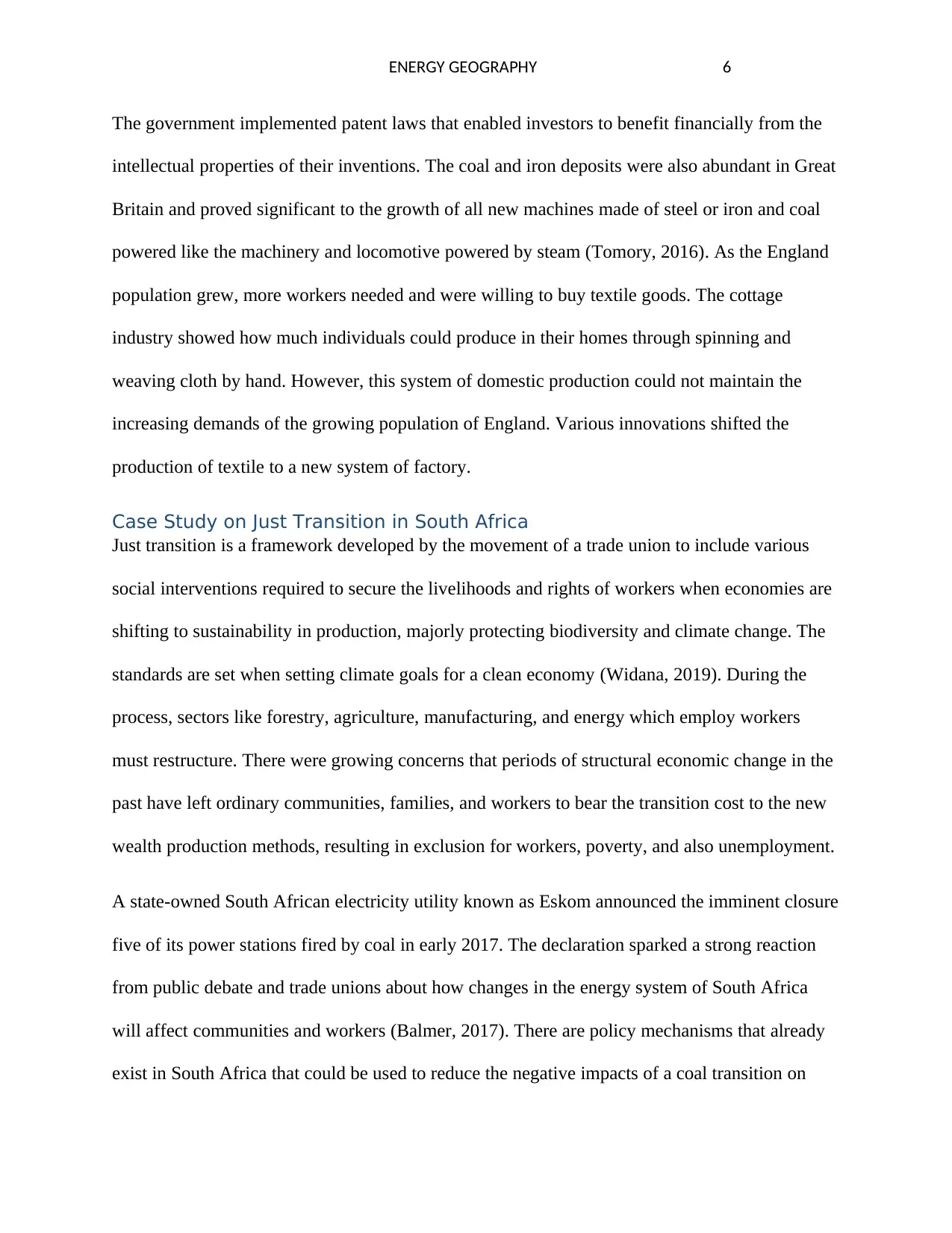
ENERGY GEOGRAPHY 6
The government implemented patent laws that enabled investors to benefit financially from the
intellectual properties of their inventions. The coal and iron deposits were also abundant in Great
Britain and proved significant to the growth of all new machines made of steel or iron and coal
powered like the machinery and locomotive powered by steam (Tomory, 2016). As the England
population grew, more workers needed and were willing to buy textile goods. The cottage
industry showed how much individuals could produce in their homes through spinning and
weaving cloth by hand. However, this system of domestic production could not maintain the
increasing demands of the growing population of England. Various innovations shifted the
production of textile to a new system of factory.
Case Study on Just Transition in South Africa
Just transition is a framework developed by the movement of a trade union to include various
social interventions required to secure the livelihoods and rights of workers when economies are
shifting to sustainability in production, majorly protecting biodiversity and climate change. The
standards are set when setting climate goals for a clean economy (Widana, 2019). During the
process, sectors like forestry, agriculture, manufacturing, and energy which employ workers
must restructure. There were growing concerns that periods of structural economic change in the
past have left ordinary communities, families, and workers to bear the transition cost to the new
wealth production methods, resulting in exclusion for workers, poverty, and also unemployment.
A state-owned South African electricity utility known as Eskom announced the imminent closure
five of its power stations fired by coal in early 2017. The declaration sparked a strong reaction
from public debate and trade unions about how changes in the energy system of South Africa
will affect communities and workers (Balmer, 2017). There are policy mechanisms that already
exist in South Africa that could be used to reduce the negative impacts of a coal transition on
The government implemented patent laws that enabled investors to benefit financially from the
intellectual properties of their inventions. The coal and iron deposits were also abundant in Great
Britain and proved significant to the growth of all new machines made of steel or iron and coal
powered like the machinery and locomotive powered by steam (Tomory, 2016). As the England
population grew, more workers needed and were willing to buy textile goods. The cottage
industry showed how much individuals could produce in their homes through spinning and
weaving cloth by hand. However, this system of domestic production could not maintain the
increasing demands of the growing population of England. Various innovations shifted the
production of textile to a new system of factory.
Case Study on Just Transition in South Africa
Just transition is a framework developed by the movement of a trade union to include various
social interventions required to secure the livelihoods and rights of workers when economies are
shifting to sustainability in production, majorly protecting biodiversity and climate change. The
standards are set when setting climate goals for a clean economy (Widana, 2019). During the
process, sectors like forestry, agriculture, manufacturing, and energy which employ workers
must restructure. There were growing concerns that periods of structural economic change in the
past have left ordinary communities, families, and workers to bear the transition cost to the new
wealth production methods, resulting in exclusion for workers, poverty, and also unemployment.
A state-owned South African electricity utility known as Eskom announced the imminent closure
five of its power stations fired by coal in early 2017. The declaration sparked a strong reaction
from public debate and trade unions about how changes in the energy system of South Africa
will affect communities and workers (Balmer, 2017). There are policy mechanisms that already
exist in South Africa that could be used to reduce the negative impacts of a coal transition on
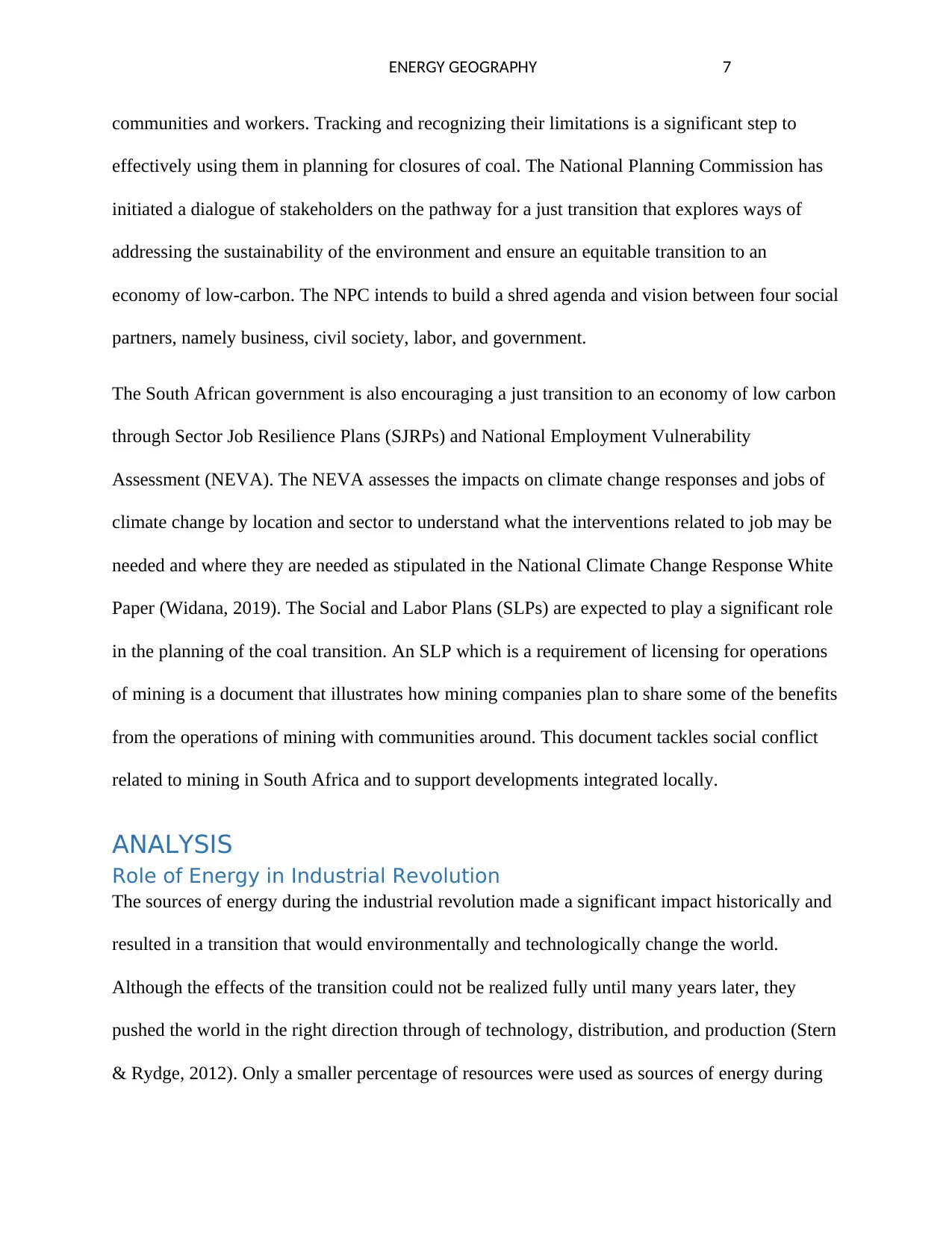
ENERGY GEOGRAPHY 7
communities and workers. Tracking and recognizing their limitations is a significant step to
effectively using them in planning for closures of coal. The National Planning Commission has
initiated a dialogue of stakeholders on the pathway for a just transition that explores ways of
addressing the sustainability of the environment and ensure an equitable transition to an
economy of low-carbon. The NPC intends to build a shred agenda and vision between four social
partners, namely business, civil society, labor, and government.
The South African government is also encouraging a just transition to an economy of low carbon
through Sector Job Resilience Plans (SJRPs) and National Employment Vulnerability
Assessment (NEVA). The NEVA assesses the impacts on climate change responses and jobs of
climate change by location and sector to understand what the interventions related to job may be
needed and where they are needed as stipulated in the National Climate Change Response White
Paper (Widana, 2019). The Social and Labor Plans (SLPs) are expected to play a significant role
in the planning of the coal transition. An SLP which is a requirement of licensing for operations
of mining is a document that illustrates how mining companies plan to share some of the benefits
from the operations of mining with communities around. This document tackles social conflict
related to mining in South Africa and to support developments integrated locally.
ANALYSIS
Role of Energy in Industrial Revolution
The sources of energy during the industrial revolution made a significant impact historically and
resulted in a transition that would environmentally and technologically change the world.
Although the effects of the transition could not be realized fully until many years later, they
pushed the world in the right direction through of technology, distribution, and production (Stern
& Rydge, 2012). Only a smaller percentage of resources were used as sources of energy during
communities and workers. Tracking and recognizing their limitations is a significant step to
effectively using them in planning for closures of coal. The National Planning Commission has
initiated a dialogue of stakeholders on the pathway for a just transition that explores ways of
addressing the sustainability of the environment and ensure an equitable transition to an
economy of low-carbon. The NPC intends to build a shred agenda and vision between four social
partners, namely business, civil society, labor, and government.
The South African government is also encouraging a just transition to an economy of low carbon
through Sector Job Resilience Plans (SJRPs) and National Employment Vulnerability
Assessment (NEVA). The NEVA assesses the impacts on climate change responses and jobs of
climate change by location and sector to understand what the interventions related to job may be
needed and where they are needed as stipulated in the National Climate Change Response White
Paper (Widana, 2019). The Social and Labor Plans (SLPs) are expected to play a significant role
in the planning of the coal transition. An SLP which is a requirement of licensing for operations
of mining is a document that illustrates how mining companies plan to share some of the benefits
from the operations of mining with communities around. This document tackles social conflict
related to mining in South Africa and to support developments integrated locally.
ANALYSIS
Role of Energy in Industrial Revolution
The sources of energy during the industrial revolution made a significant impact historically and
resulted in a transition that would environmentally and technologically change the world.
Although the effects of the transition could not be realized fully until many years later, they
pushed the world in the right direction through of technology, distribution, and production (Stern
& Rydge, 2012). Only a smaller percentage of resources were used as sources of energy during
Paraphrase This Document
Need a fresh take? Get an instant paraphrase of this document with our AI Paraphraser
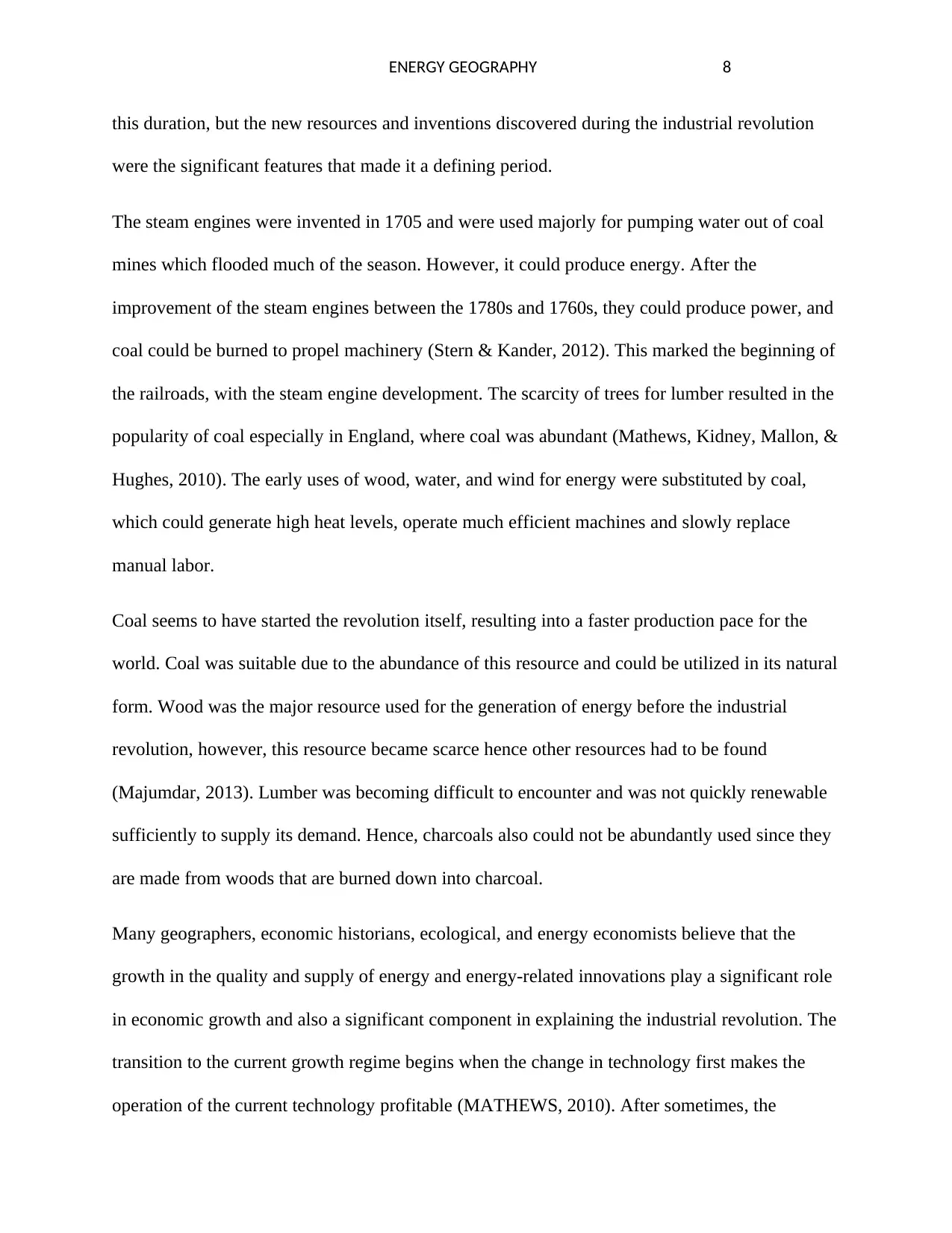
ENERGY GEOGRAPHY 8
this duration, but the new resources and inventions discovered during the industrial revolution
were the significant features that made it a defining period.
The steam engines were invented in 1705 and were used majorly for pumping water out of coal
mines which flooded much of the season. However, it could produce energy. After the
improvement of the steam engines between the 1780s and 1760s, they could produce power, and
coal could be burned to propel machinery (Stern & Kander, 2012). This marked the beginning of
the railroads, with the steam engine development. The scarcity of trees for lumber resulted in the
popularity of coal especially in England, where coal was abundant (Mathews, Kidney, Mallon, &
Hughes, 2010). The early uses of wood, water, and wind for energy were substituted by coal,
which could generate high heat levels, operate much efficient machines and slowly replace
manual labor.
Coal seems to have started the revolution itself, resulting into a faster production pace for the
world. Coal was suitable due to the abundance of this resource and could be utilized in its natural
form. Wood was the major resource used for the generation of energy before the industrial
revolution, however, this resource became scarce hence other resources had to be found
(Majumdar, 2013). Lumber was becoming difficult to encounter and was not quickly renewable
sufficiently to supply its demand. Hence, charcoals also could not be abundantly used since they
are made from woods that are burned down into charcoal.
Many geographers, economic historians, ecological, and energy economists believe that the
growth in the quality and supply of energy and energy-related innovations play a significant role
in economic growth and also a significant component in explaining the industrial revolution. The
transition to the current growth regime begins when the change in technology first makes the
operation of the current technology profitable (MATHEWS, 2010). After sometimes, the
this duration, but the new resources and inventions discovered during the industrial revolution
were the significant features that made it a defining period.
The steam engines were invented in 1705 and were used majorly for pumping water out of coal
mines which flooded much of the season. However, it could produce energy. After the
improvement of the steam engines between the 1780s and 1760s, they could produce power, and
coal could be burned to propel machinery (Stern & Kander, 2012). This marked the beginning of
the railroads, with the steam engine development. The scarcity of trees for lumber resulted in the
popularity of coal especially in England, where coal was abundant (Mathews, Kidney, Mallon, &
Hughes, 2010). The early uses of wood, water, and wind for energy were substituted by coal,
which could generate high heat levels, operate much efficient machines and slowly replace
manual labor.
Coal seems to have started the revolution itself, resulting into a faster production pace for the
world. Coal was suitable due to the abundance of this resource and could be utilized in its natural
form. Wood was the major resource used for the generation of energy before the industrial
revolution, however, this resource became scarce hence other resources had to be found
(Majumdar, 2013). Lumber was becoming difficult to encounter and was not quickly renewable
sufficiently to supply its demand. Hence, charcoals also could not be abundantly used since they
are made from woods that are burned down into charcoal.
Many geographers, economic historians, ecological, and energy economists believe that the
growth in the quality and supply of energy and energy-related innovations play a significant role
in economic growth and also a significant component in explaining the industrial revolution. The
transition to the current growth regime begins when the change in technology first makes the
operation of the current technology profitable (MATHEWS, 2010). After sometimes, the
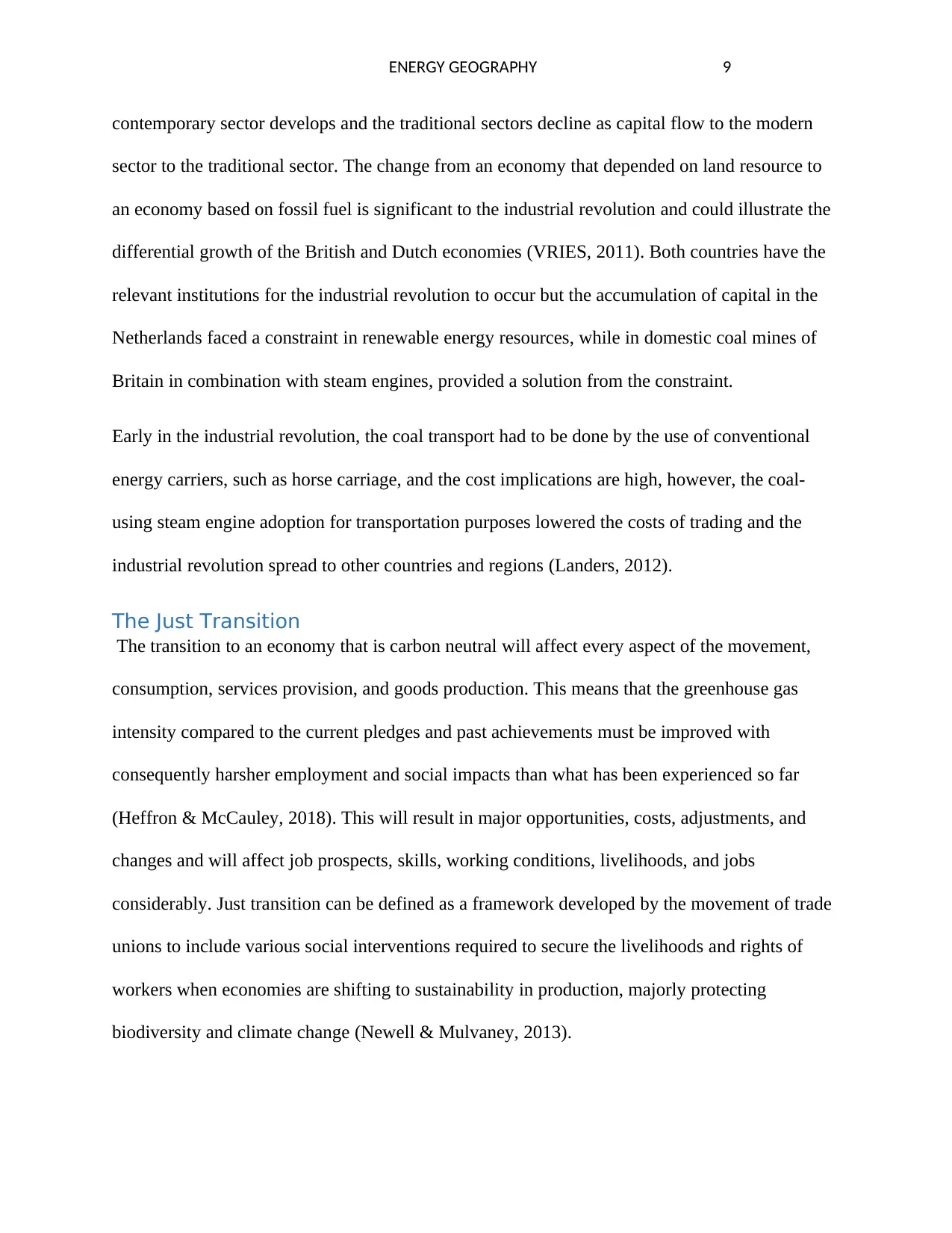
ENERGY GEOGRAPHY 9
contemporary sector develops and the traditional sectors decline as capital flow to the modern
sector to the traditional sector. The change from an economy that depended on land resource to
an economy based on fossil fuel is significant to the industrial revolution and could illustrate the
differential growth of the British and Dutch economies (VRIES, 2011). Both countries have the
relevant institutions for the industrial revolution to occur but the accumulation of capital in the
Netherlands faced a constraint in renewable energy resources, while in domestic coal mines of
Britain in combination with steam engines, provided a solution from the constraint.
Early in the industrial revolution, the coal transport had to be done by the use of conventional
energy carriers, such as horse carriage, and the cost implications are high, however, the coal-
using steam engine adoption for transportation purposes lowered the costs of trading and the
industrial revolution spread to other countries and regions (Landers, 2012).
The Just Transition
The transition to an economy that is carbon neutral will affect every aspect of the movement,
consumption, services provision, and goods production. This means that the greenhouse gas
intensity compared to the current pledges and past achievements must be improved with
consequently harsher employment and social impacts than what has been experienced so far
(Heffron & McCauley, 2018). This will result in major opportunities, costs, adjustments, and
changes and will affect job prospects, skills, working conditions, livelihoods, and jobs
considerably. Just transition can be defined as a framework developed by the movement of trade
unions to include various social interventions required to secure the livelihoods and rights of
workers when economies are shifting to sustainability in production, majorly protecting
biodiversity and climate change (Newell & Mulvaney, 2013).
contemporary sector develops and the traditional sectors decline as capital flow to the modern
sector to the traditional sector. The change from an economy that depended on land resource to
an economy based on fossil fuel is significant to the industrial revolution and could illustrate the
differential growth of the British and Dutch economies (VRIES, 2011). Both countries have the
relevant institutions for the industrial revolution to occur but the accumulation of capital in the
Netherlands faced a constraint in renewable energy resources, while in domestic coal mines of
Britain in combination with steam engines, provided a solution from the constraint.
Early in the industrial revolution, the coal transport had to be done by the use of conventional
energy carriers, such as horse carriage, and the cost implications are high, however, the coal-
using steam engine adoption for transportation purposes lowered the costs of trading and the
industrial revolution spread to other countries and regions (Landers, 2012).
The Just Transition
The transition to an economy that is carbon neutral will affect every aspect of the movement,
consumption, services provision, and goods production. This means that the greenhouse gas
intensity compared to the current pledges and past achievements must be improved with
consequently harsher employment and social impacts than what has been experienced so far
(Heffron & McCauley, 2018). This will result in major opportunities, costs, adjustments, and
changes and will affect job prospects, skills, working conditions, livelihoods, and jobs
considerably. Just transition can be defined as a framework developed by the movement of trade
unions to include various social interventions required to secure the livelihoods and rights of
workers when economies are shifting to sustainability in production, majorly protecting
biodiversity and climate change (Newell & Mulvaney, 2013).
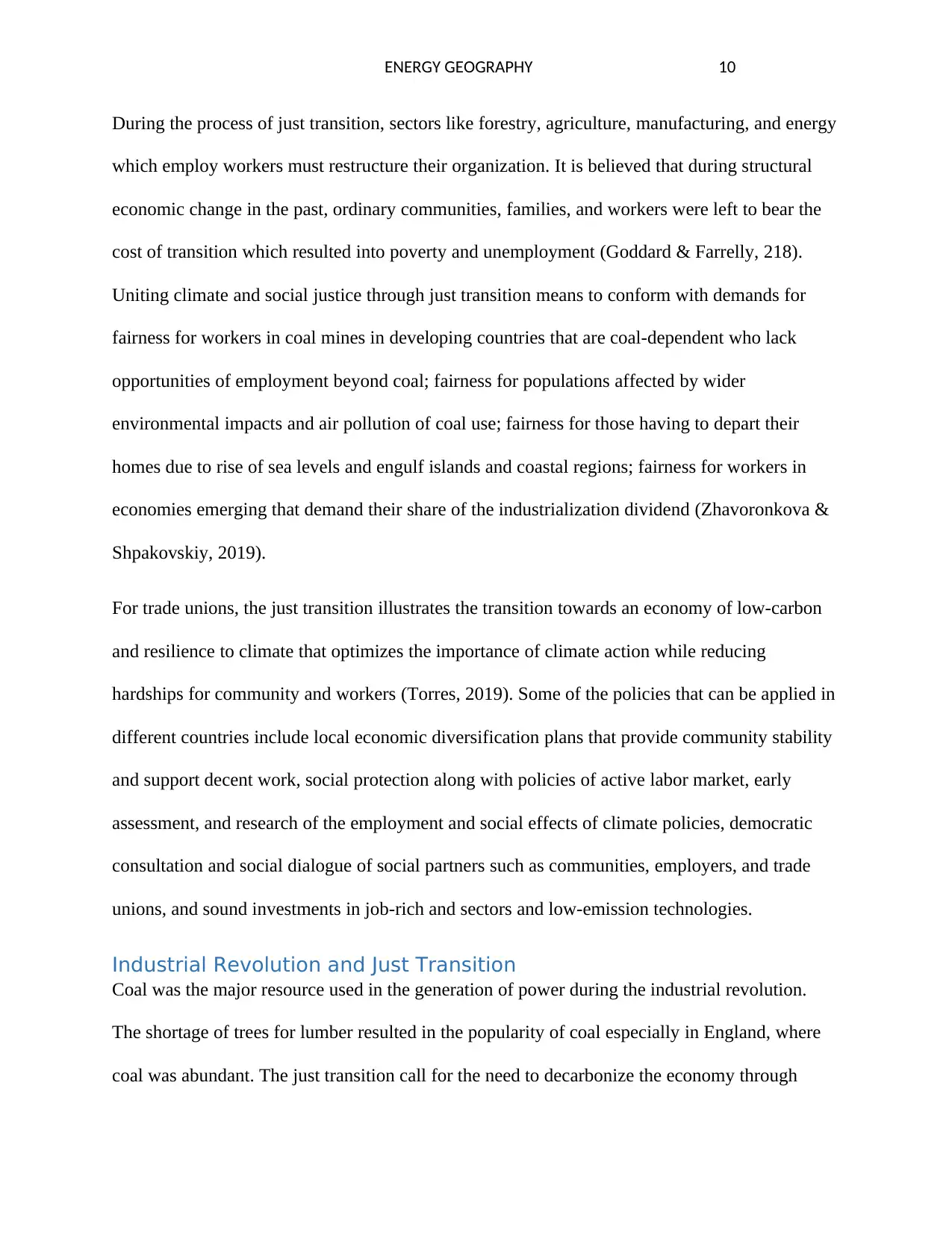
ENERGY GEOGRAPHY 10
During the process of just transition, sectors like forestry, agriculture, manufacturing, and energy
which employ workers must restructure their organization. It is believed that during structural
economic change in the past, ordinary communities, families, and workers were left to bear the
cost of transition which resulted into poverty and unemployment (Goddard & Farrelly, 218).
Uniting climate and social justice through just transition means to conform with demands for
fairness for workers in coal mines in developing countries that are coal-dependent who lack
opportunities of employment beyond coal; fairness for populations affected by wider
environmental impacts and air pollution of coal use; fairness for those having to depart their
homes due to rise of sea levels and engulf islands and coastal regions; fairness for workers in
economies emerging that demand their share of the industrialization dividend (Zhavoronkova &
Shpakovskiy, 2019).
For trade unions, the just transition illustrates the transition towards an economy of low-carbon
and resilience to climate that optimizes the importance of climate action while reducing
hardships for community and workers (Torres, 2019). Some of the policies that can be applied in
different countries include local economic diversification plans that provide community stability
and support decent work, social protection along with policies of active labor market, early
assessment, and research of the employment and social effects of climate policies, democratic
consultation and social dialogue of social partners such as communities, employers, and trade
unions, and sound investments in job-rich and sectors and low-emission technologies.
Industrial Revolution and Just Transition
Coal was the major resource used in the generation of power during the industrial revolution.
The shortage of trees for lumber resulted in the popularity of coal especially in England, where
coal was abundant. The just transition call for the need to decarbonize the economy through
During the process of just transition, sectors like forestry, agriculture, manufacturing, and energy
which employ workers must restructure their organization. It is believed that during structural
economic change in the past, ordinary communities, families, and workers were left to bear the
cost of transition which resulted into poverty and unemployment (Goddard & Farrelly, 218).
Uniting climate and social justice through just transition means to conform with demands for
fairness for workers in coal mines in developing countries that are coal-dependent who lack
opportunities of employment beyond coal; fairness for populations affected by wider
environmental impacts and air pollution of coal use; fairness for those having to depart their
homes due to rise of sea levels and engulf islands and coastal regions; fairness for workers in
economies emerging that demand their share of the industrialization dividend (Zhavoronkova &
Shpakovskiy, 2019).
For trade unions, the just transition illustrates the transition towards an economy of low-carbon
and resilience to climate that optimizes the importance of climate action while reducing
hardships for community and workers (Torres, 2019). Some of the policies that can be applied in
different countries include local economic diversification plans that provide community stability
and support decent work, social protection along with policies of active labor market, early
assessment, and research of the employment and social effects of climate policies, democratic
consultation and social dialogue of social partners such as communities, employers, and trade
unions, and sound investments in job-rich and sectors and low-emission technologies.
Industrial Revolution and Just Transition
Coal was the major resource used in the generation of power during the industrial revolution.
The shortage of trees for lumber resulted in the popularity of coal especially in England, where
coal was abundant. The just transition call for the need to decarbonize the economy through
Secure Best Marks with AI Grader
Need help grading? Try our AI Grader for instant feedback on your assignments.
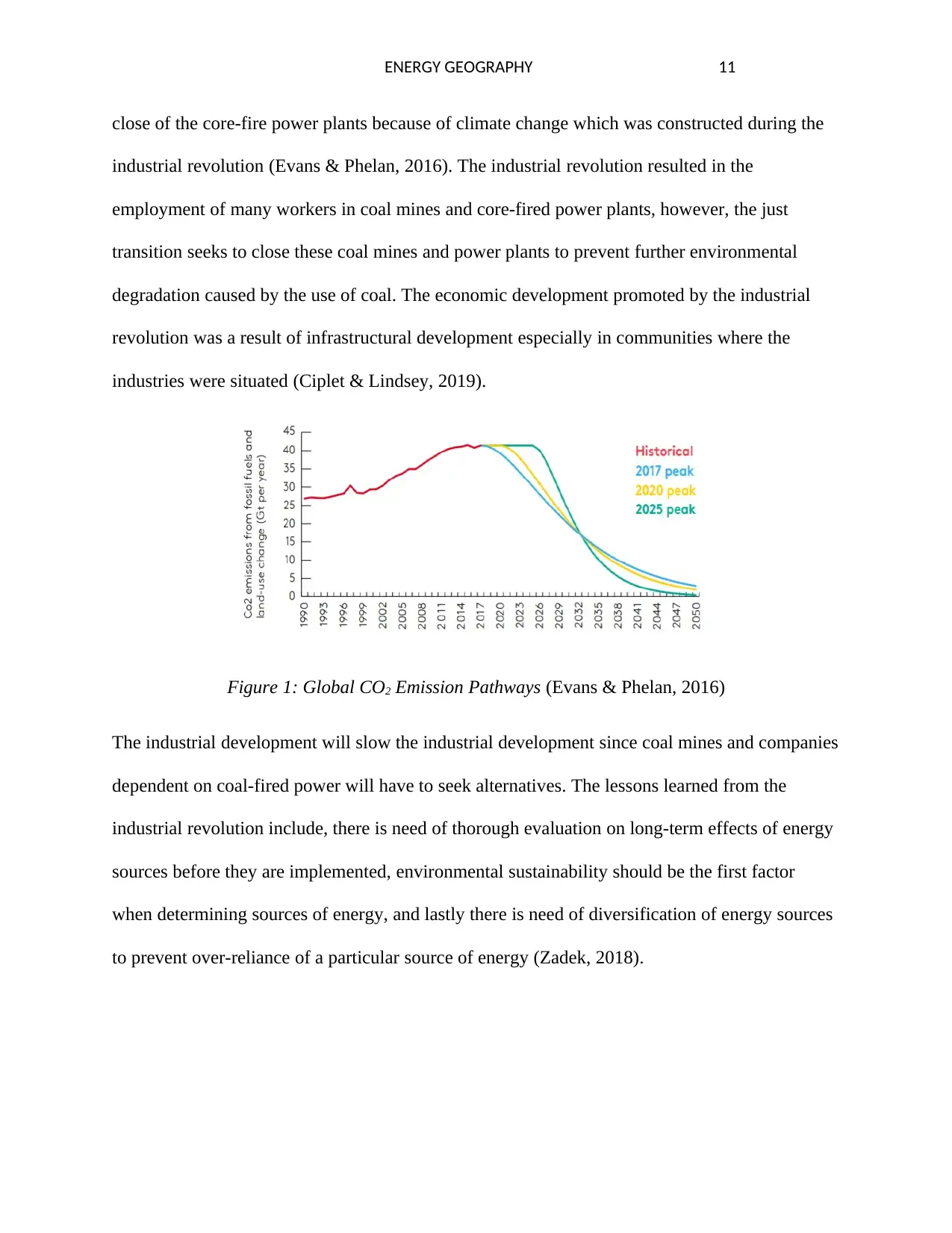
ENERGY GEOGRAPHY 11
close of the core-fire power plants because of climate change which was constructed during the
industrial revolution (Evans & Phelan, 2016). The industrial revolution resulted in the
employment of many workers in coal mines and core-fired power plants, however, the just
transition seeks to close these coal mines and power plants to prevent further environmental
degradation caused by the use of coal. The economic development promoted by the industrial
revolution was a result of infrastructural development especially in communities where the
industries were situated (Ciplet & Lindsey, 2019).
Figure 1: Global CO2 Emission Pathways (Evans & Phelan, 2016)
The industrial development will slow the industrial development since coal mines and companies
dependent on coal-fired power will have to seek alternatives. The lessons learned from the
industrial revolution include, there is need of thorough evaluation on long-term effects of energy
sources before they are implemented, environmental sustainability should be the first factor
when determining sources of energy, and lastly there is need of diversification of energy sources
to prevent over-reliance of a particular source of energy (Zadek, 2018).
close of the core-fire power plants because of climate change which was constructed during the
industrial revolution (Evans & Phelan, 2016). The industrial revolution resulted in the
employment of many workers in coal mines and core-fired power plants, however, the just
transition seeks to close these coal mines and power plants to prevent further environmental
degradation caused by the use of coal. The economic development promoted by the industrial
revolution was a result of infrastructural development especially in communities where the
industries were situated (Ciplet & Lindsey, 2019).
Figure 1: Global CO2 Emission Pathways (Evans & Phelan, 2016)
The industrial development will slow the industrial development since coal mines and companies
dependent on coal-fired power will have to seek alternatives. The lessons learned from the
industrial revolution include, there is need of thorough evaluation on long-term effects of energy
sources before they are implemented, environmental sustainability should be the first factor
when determining sources of energy, and lastly there is need of diversification of energy sources
to prevent over-reliance of a particular source of energy (Zadek, 2018).
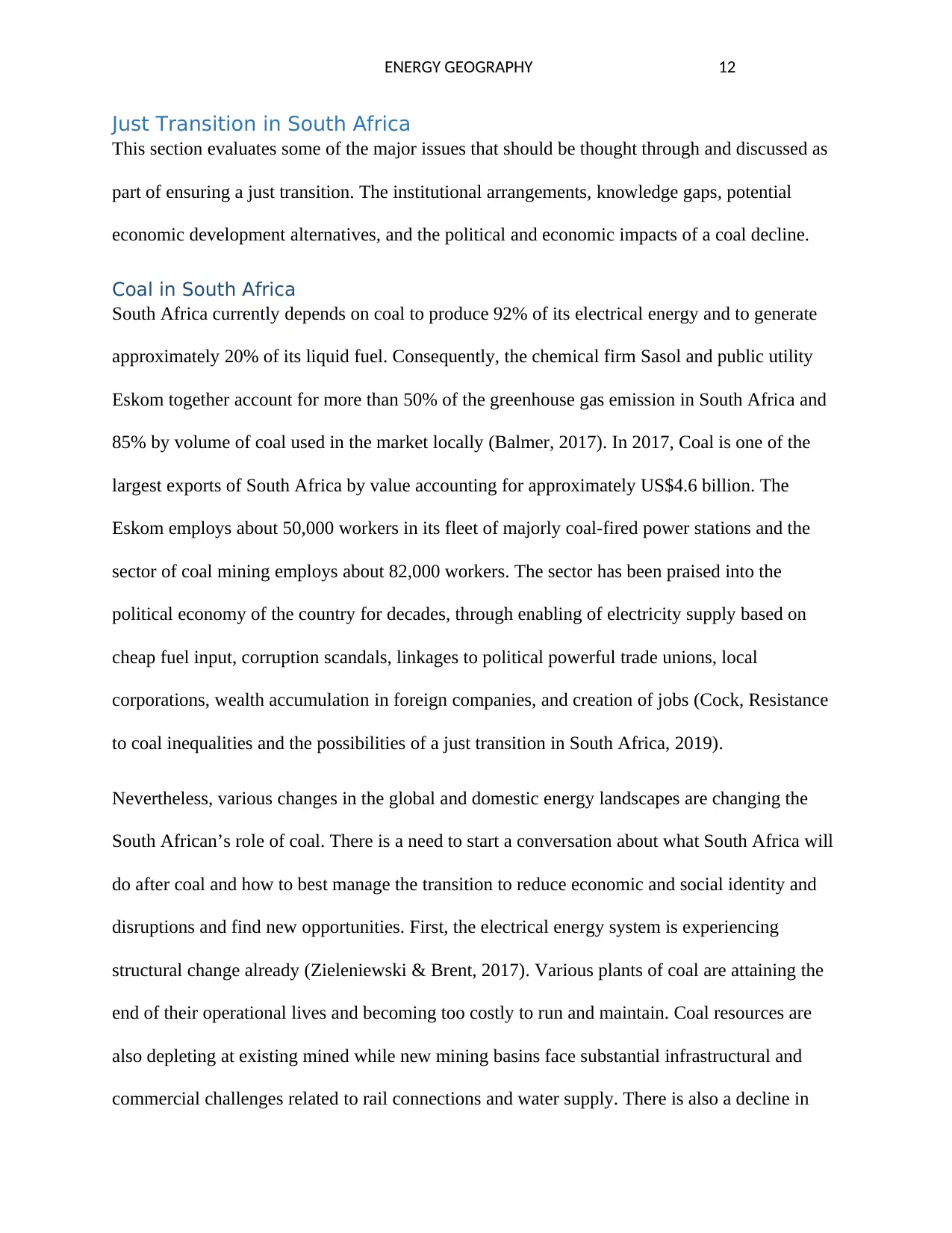
ENERGY GEOGRAPHY 12
Just Transition in South Africa
This section evaluates some of the major issues that should be thought through and discussed as
part of ensuring a just transition. The institutional arrangements, knowledge gaps, potential
economic development alternatives, and the political and economic impacts of a coal decline.
Coal in South Africa
South Africa currently depends on coal to produce 92% of its electrical energy and to generate
approximately 20% of its liquid fuel. Consequently, the chemical firm Sasol and public utility
Eskom together account for more than 50% of the greenhouse gas emission in South Africa and
85% by volume of coal used in the market locally (Balmer, 2017). In 2017, Coal is one of the
largest exports of South Africa by value accounting for approximately US$4.6 billion. The
Eskom employs about 50,000 workers in its fleet of majorly coal-fired power stations and the
sector of coal mining employs about 82,000 workers. The sector has been praised into the
political economy of the country for decades, through enabling of electricity supply based on
cheap fuel input, corruption scandals, linkages to political powerful trade unions, local
corporations, wealth accumulation in foreign companies, and creation of jobs (Cock, Resistance
to coal inequalities and the possibilities of a just transition in South Africa, 2019).
Nevertheless, various changes in the global and domestic energy landscapes are changing the
South African’s role of coal. There is a need to start a conversation about what South Africa will
do after coal and how to best manage the transition to reduce economic and social identity and
disruptions and find new opportunities. First, the electrical energy system is experiencing
structural change already (Zieleniewski & Brent, 2017). Various plants of coal are attaining the
end of their operational lives and becoming too costly to run and maintain. Coal resources are
also depleting at existing mined while new mining basins face substantial infrastructural and
commercial challenges related to rail connections and water supply. There is also a decline in
Just Transition in South Africa
This section evaluates some of the major issues that should be thought through and discussed as
part of ensuring a just transition. The institutional arrangements, knowledge gaps, potential
economic development alternatives, and the political and economic impacts of a coal decline.
Coal in South Africa
South Africa currently depends on coal to produce 92% of its electrical energy and to generate
approximately 20% of its liquid fuel. Consequently, the chemical firm Sasol and public utility
Eskom together account for more than 50% of the greenhouse gas emission in South Africa and
85% by volume of coal used in the market locally (Balmer, 2017). In 2017, Coal is one of the
largest exports of South Africa by value accounting for approximately US$4.6 billion. The
Eskom employs about 50,000 workers in its fleet of majorly coal-fired power stations and the
sector of coal mining employs about 82,000 workers. The sector has been praised into the
political economy of the country for decades, through enabling of electricity supply based on
cheap fuel input, corruption scandals, linkages to political powerful trade unions, local
corporations, wealth accumulation in foreign companies, and creation of jobs (Cock, Resistance
to coal inequalities and the possibilities of a just transition in South Africa, 2019).
Nevertheless, various changes in the global and domestic energy landscapes are changing the
South African’s role of coal. There is a need to start a conversation about what South Africa will
do after coal and how to best manage the transition to reduce economic and social identity and
disruptions and find new opportunities. First, the electrical energy system is experiencing
structural change already (Zieleniewski & Brent, 2017). Various plants of coal are attaining the
end of their operational lives and becoming too costly to run and maintain. Coal resources are
also depleting at existing mined while new mining basins face substantial infrastructural and
commercial challenges related to rail connections and water supply. There is also a decline in
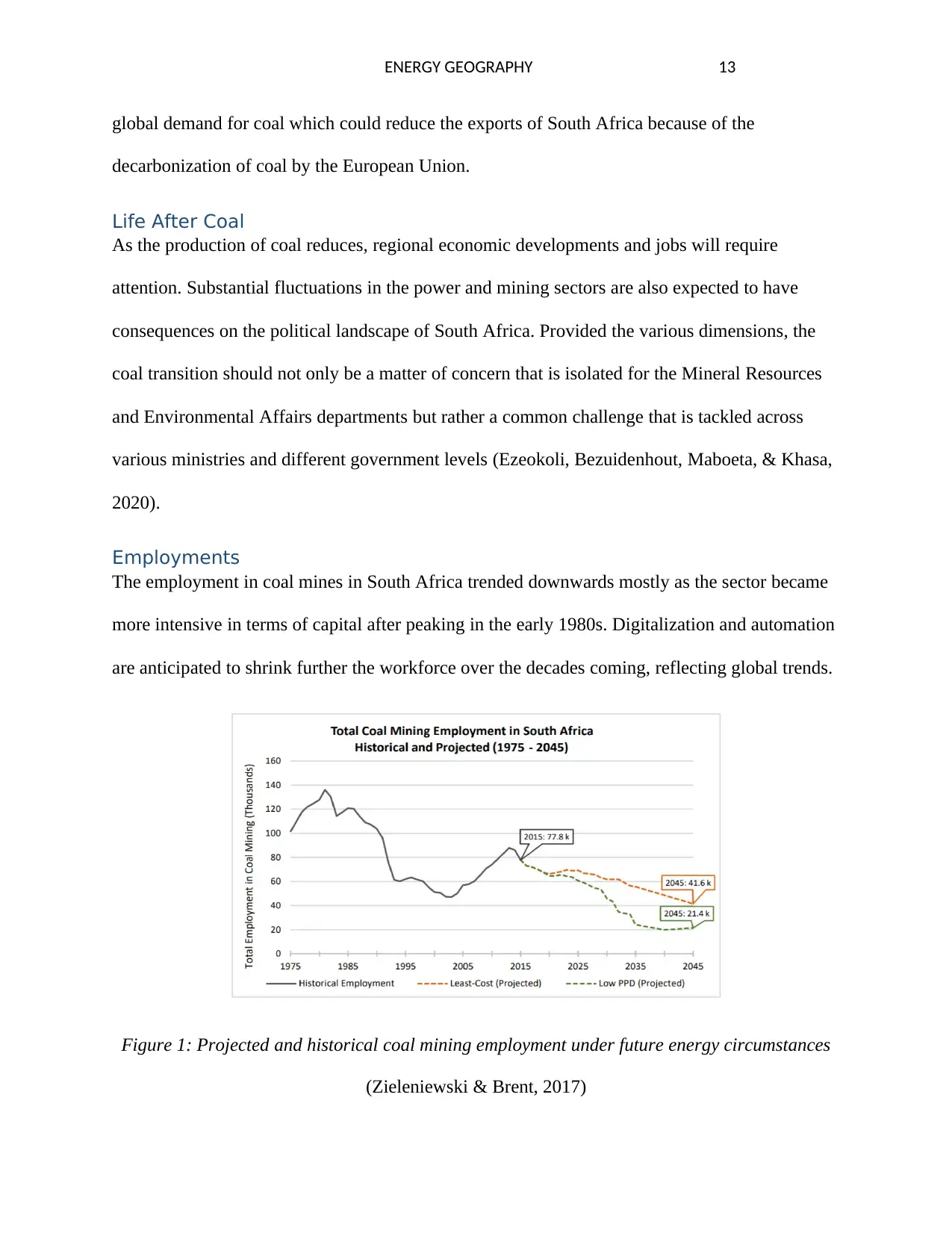
ENERGY GEOGRAPHY 13
global demand for coal which could reduce the exports of South Africa because of the
decarbonization of coal by the European Union.
Life After Coal
As the production of coal reduces, regional economic developments and jobs will require
attention. Substantial fluctuations in the power and mining sectors are also expected to have
consequences on the political landscape of South Africa. Provided the various dimensions, the
coal transition should not only be a matter of concern that is isolated for the Mineral Resources
and Environmental Affairs departments but rather a common challenge that is tackled across
various ministries and different government levels (Ezeokoli, Bezuidenhout, Maboeta, & Khasa,
2020).
Employments
The employment in coal mines in South Africa trended downwards mostly as the sector became
more intensive in terms of capital after peaking in the early 1980s. Digitalization and automation
are anticipated to shrink further the workforce over the decades coming, reflecting global trends.
Figure 1: Projected and historical coal mining employment under future energy circumstances
(Zieleniewski & Brent, 2017)
global demand for coal which could reduce the exports of South Africa because of the
decarbonization of coal by the European Union.
Life After Coal
As the production of coal reduces, regional economic developments and jobs will require
attention. Substantial fluctuations in the power and mining sectors are also expected to have
consequences on the political landscape of South Africa. Provided the various dimensions, the
coal transition should not only be a matter of concern that is isolated for the Mineral Resources
and Environmental Affairs departments but rather a common challenge that is tackled across
various ministries and different government levels (Ezeokoli, Bezuidenhout, Maboeta, & Khasa,
2020).
Employments
The employment in coal mines in South Africa trended downwards mostly as the sector became
more intensive in terms of capital after peaking in the early 1980s. Digitalization and automation
are anticipated to shrink further the workforce over the decades coming, reflecting global trends.
Figure 1: Projected and historical coal mining employment under future energy circumstances
(Zieleniewski & Brent, 2017)
Paraphrase This Document
Need a fresh take? Get an instant paraphrase of this document with our AI Paraphraser
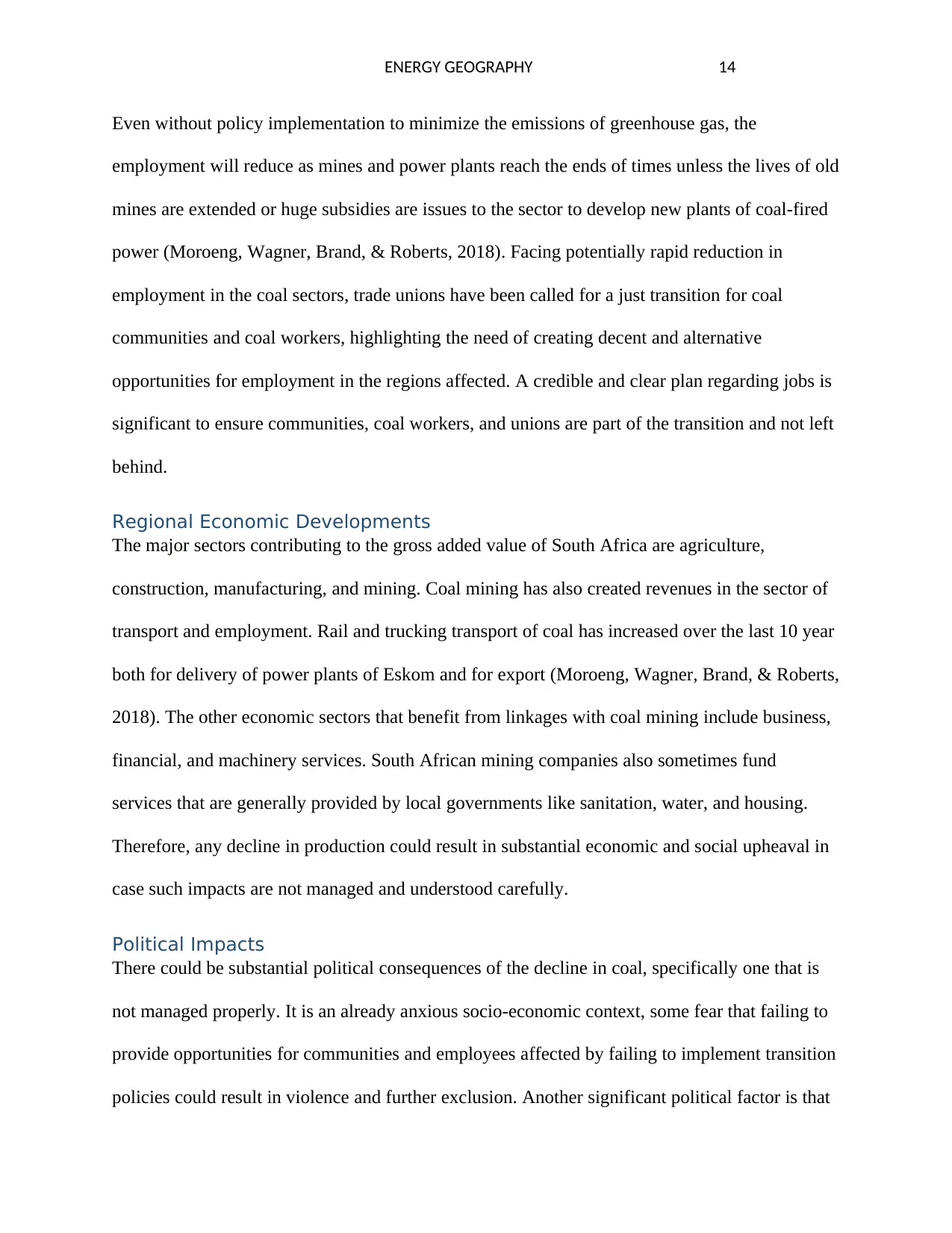
ENERGY GEOGRAPHY 14
Even without policy implementation to minimize the emissions of greenhouse gas, the
employment will reduce as mines and power plants reach the ends of times unless the lives of old
mines are extended or huge subsidies are issues to the sector to develop new plants of coal-fired
power (Moroeng, Wagner, Brand, & Roberts, 2018). Facing potentially rapid reduction in
employment in the coal sectors, trade unions have been called for a just transition for coal
communities and coal workers, highlighting the need of creating decent and alternative
opportunities for employment in the regions affected. A credible and clear plan regarding jobs is
significant to ensure communities, coal workers, and unions are part of the transition and not left
behind.
Regional Economic Developments
The major sectors contributing to the gross added value of South Africa are agriculture,
construction, manufacturing, and mining. Coal mining has also created revenues in the sector of
transport and employment. Rail and trucking transport of coal has increased over the last 10 year
both for delivery of power plants of Eskom and for export (Moroeng, Wagner, Brand, & Roberts,
2018). The other economic sectors that benefit from linkages with coal mining include business,
financial, and machinery services. South African mining companies also sometimes fund
services that are generally provided by local governments like sanitation, water, and housing.
Therefore, any decline in production could result in substantial economic and social upheaval in
case such impacts are not managed and understood carefully.
Political Impacts
There could be substantial political consequences of the decline in coal, specifically one that is
not managed properly. It is an already anxious socio-economic context, some fear that failing to
provide opportunities for communities and employees affected by failing to implement transition
policies could result in violence and further exclusion. Another significant political factor is that
Even without policy implementation to minimize the emissions of greenhouse gas, the
employment will reduce as mines and power plants reach the ends of times unless the lives of old
mines are extended or huge subsidies are issues to the sector to develop new plants of coal-fired
power (Moroeng, Wagner, Brand, & Roberts, 2018). Facing potentially rapid reduction in
employment in the coal sectors, trade unions have been called for a just transition for coal
communities and coal workers, highlighting the need of creating decent and alternative
opportunities for employment in the regions affected. A credible and clear plan regarding jobs is
significant to ensure communities, coal workers, and unions are part of the transition and not left
behind.
Regional Economic Developments
The major sectors contributing to the gross added value of South Africa are agriculture,
construction, manufacturing, and mining. Coal mining has also created revenues in the sector of
transport and employment. Rail and trucking transport of coal has increased over the last 10 year
both for delivery of power plants of Eskom and for export (Moroeng, Wagner, Brand, & Roberts,
2018). The other economic sectors that benefit from linkages with coal mining include business,
financial, and machinery services. South African mining companies also sometimes fund
services that are generally provided by local governments like sanitation, water, and housing.
Therefore, any decline in production could result in substantial economic and social upheaval in
case such impacts are not managed and understood carefully.
Political Impacts
There could be substantial political consequences of the decline in coal, specifically one that is
not managed properly. It is an already anxious socio-economic context, some fear that failing to
provide opportunities for communities and employees affected by failing to implement transition
policies could result in violence and further exclusion. Another significant political factor is that
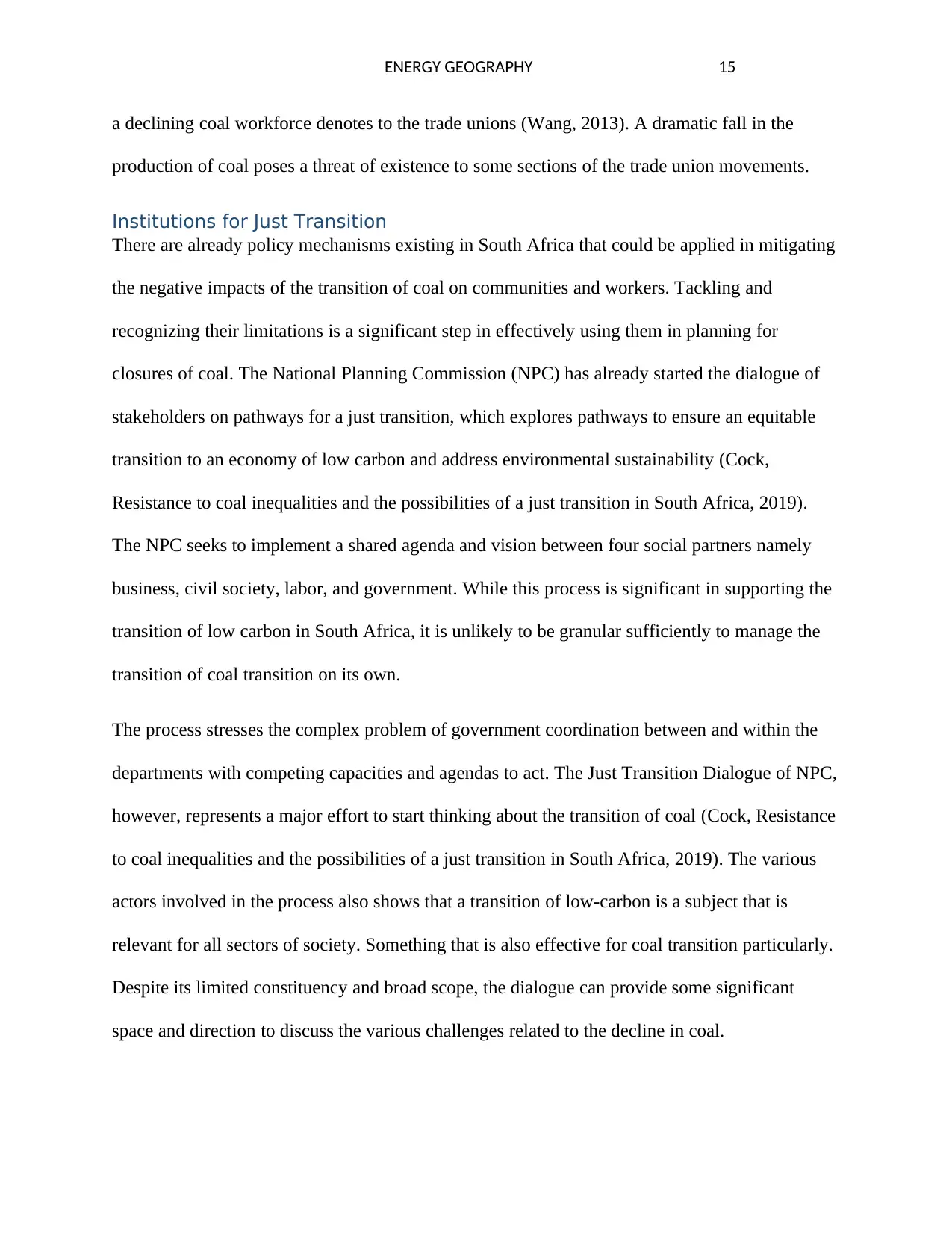
ENERGY GEOGRAPHY 15
a declining coal workforce denotes to the trade unions (Wang, 2013). A dramatic fall in the
production of coal poses a threat of existence to some sections of the trade union movements.
Institutions for Just Transition
There are already policy mechanisms existing in South Africa that could be applied in mitigating
the negative impacts of the transition of coal on communities and workers. Tackling and
recognizing their limitations is a significant step in effectively using them in planning for
closures of coal. The National Planning Commission (NPC) has already started the dialogue of
stakeholders on pathways for a just transition, which explores pathways to ensure an equitable
transition to an economy of low carbon and address environmental sustainability (Cock,
Resistance to coal inequalities and the possibilities of a just transition in South Africa, 2019).
The NPC seeks to implement a shared agenda and vision between four social partners namely
business, civil society, labor, and government. While this process is significant in supporting the
transition of low carbon in South Africa, it is unlikely to be granular sufficiently to manage the
transition of coal transition on its own.
The process stresses the complex problem of government coordination between and within the
departments with competing capacities and agendas to act. The Just Transition Dialogue of NPC,
however, represents a major effort to start thinking about the transition of coal (Cock, Resistance
to coal inequalities and the possibilities of a just transition in South Africa, 2019). The various
actors involved in the process also shows that a transition of low-carbon is a subject that is
relevant for all sectors of society. Something that is also effective for coal transition particularly.
Despite its limited constituency and broad scope, the dialogue can provide some significant
space and direction to discuss the various challenges related to the decline in coal.
a declining coal workforce denotes to the trade unions (Wang, 2013). A dramatic fall in the
production of coal poses a threat of existence to some sections of the trade union movements.
Institutions for Just Transition
There are already policy mechanisms existing in South Africa that could be applied in mitigating
the negative impacts of the transition of coal on communities and workers. Tackling and
recognizing their limitations is a significant step in effectively using them in planning for
closures of coal. The National Planning Commission (NPC) has already started the dialogue of
stakeholders on pathways for a just transition, which explores pathways to ensure an equitable
transition to an economy of low carbon and address environmental sustainability (Cock,
Resistance to coal inequalities and the possibilities of a just transition in South Africa, 2019).
The NPC seeks to implement a shared agenda and vision between four social partners namely
business, civil society, labor, and government. While this process is significant in supporting the
transition of low carbon in South Africa, it is unlikely to be granular sufficiently to manage the
transition of coal transition on its own.
The process stresses the complex problem of government coordination between and within the
departments with competing capacities and agendas to act. The Just Transition Dialogue of NPC,
however, represents a major effort to start thinking about the transition of coal (Cock, Resistance
to coal inequalities and the possibilities of a just transition in South Africa, 2019). The various
actors involved in the process also shows that a transition of low-carbon is a subject that is
relevant for all sectors of society. Something that is also effective for coal transition particularly.
Despite its limited constituency and broad scope, the dialogue can provide some significant
space and direction to discuss the various challenges related to the decline in coal.
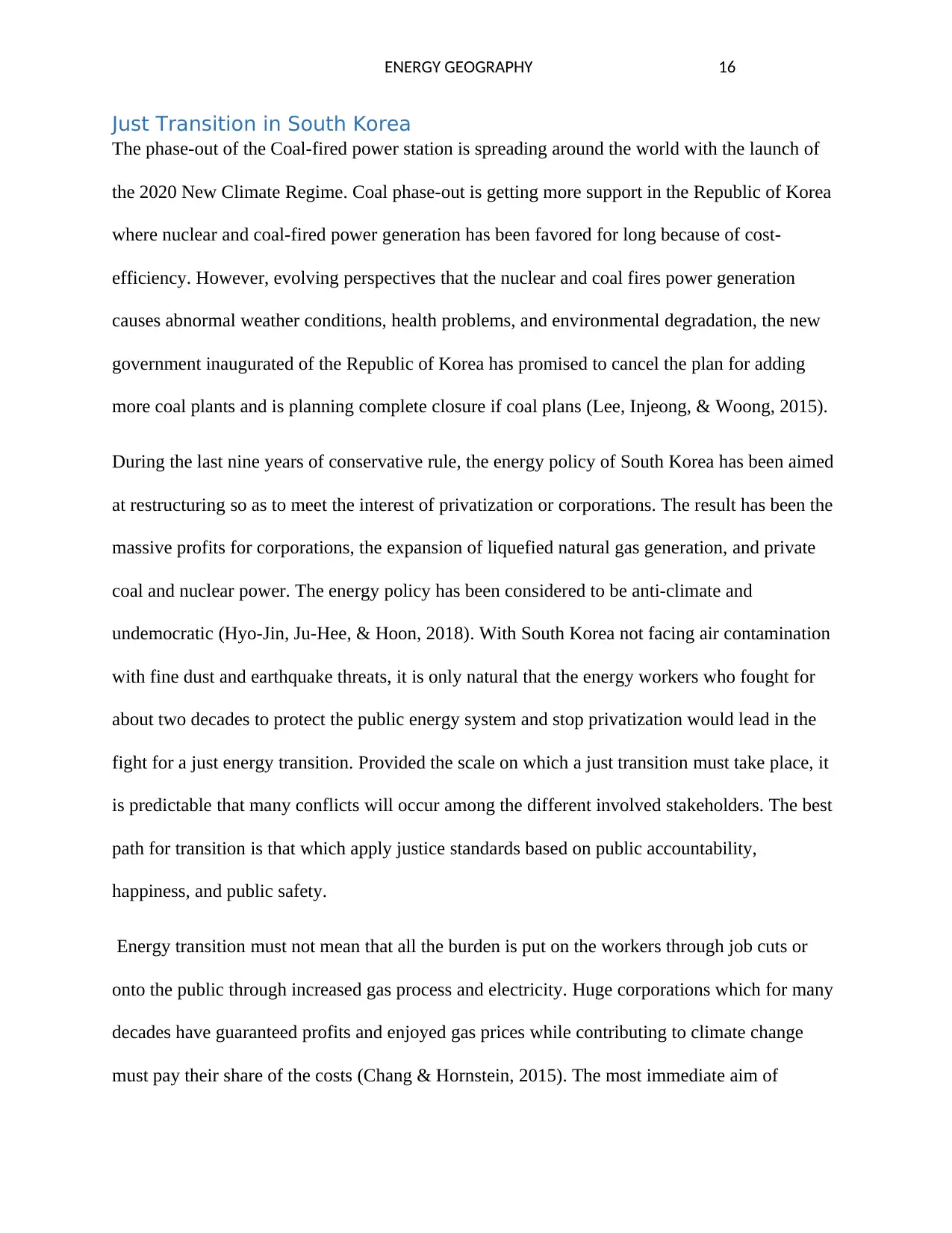
ENERGY GEOGRAPHY 16
Just Transition in South Korea
The phase-out of the Coal-fired power station is spreading around the world with the launch of
the 2020 New Climate Regime. Coal phase-out is getting more support in the Republic of Korea
where nuclear and coal-fired power generation has been favored for long because of cost-
efficiency. However, evolving perspectives that the nuclear and coal fires power generation
causes abnormal weather conditions, health problems, and environmental degradation, the new
government inaugurated of the Republic of Korea has promised to cancel the plan for adding
more coal plants and is planning complete closure if coal plans (Lee, Injeong, & Woong, 2015).
During the last nine years of conservative rule, the energy policy of South Korea has been aimed
at restructuring so as to meet the interest of privatization or corporations. The result has been the
massive profits for corporations, the expansion of liquefied natural gas generation, and private
coal and nuclear power. The energy policy has been considered to be anti-climate and
undemocratic (Hyo-Jin, Ju-Hee, & Hoon, 2018). With South Korea not facing air contamination
with fine dust and earthquake threats, it is only natural that the energy workers who fought for
about two decades to protect the public energy system and stop privatization would lead in the
fight for a just energy transition. Provided the scale on which a just transition must take place, it
is predictable that many conflicts will occur among the different involved stakeholders. The best
path for transition is that which apply justice standards based on public accountability,
happiness, and public safety.
Energy transition must not mean that all the burden is put on the workers through job cuts or
onto the public through increased gas process and electricity. Huge corporations which for many
decades have guaranteed profits and enjoyed gas prices while contributing to climate change
must pay their share of the costs (Chang & Hornstein, 2015). The most immediate aim of
Just Transition in South Korea
The phase-out of the Coal-fired power station is spreading around the world with the launch of
the 2020 New Climate Regime. Coal phase-out is getting more support in the Republic of Korea
where nuclear and coal-fired power generation has been favored for long because of cost-
efficiency. However, evolving perspectives that the nuclear and coal fires power generation
causes abnormal weather conditions, health problems, and environmental degradation, the new
government inaugurated of the Republic of Korea has promised to cancel the plan for adding
more coal plants and is planning complete closure if coal plans (Lee, Injeong, & Woong, 2015).
During the last nine years of conservative rule, the energy policy of South Korea has been aimed
at restructuring so as to meet the interest of privatization or corporations. The result has been the
massive profits for corporations, the expansion of liquefied natural gas generation, and private
coal and nuclear power. The energy policy has been considered to be anti-climate and
undemocratic (Hyo-Jin, Ju-Hee, & Hoon, 2018). With South Korea not facing air contamination
with fine dust and earthquake threats, it is only natural that the energy workers who fought for
about two decades to protect the public energy system and stop privatization would lead in the
fight for a just energy transition. Provided the scale on which a just transition must take place, it
is predictable that many conflicts will occur among the different involved stakeholders. The best
path for transition is that which apply justice standards based on public accountability,
happiness, and public safety.
Energy transition must not mean that all the burden is put on the workers through job cuts or
onto the public through increased gas process and electricity. Huge corporations which for many
decades have guaranteed profits and enjoyed gas prices while contributing to climate change
must pay their share of the costs (Chang & Hornstein, 2015). The most immediate aim of
Secure Best Marks with AI Grader
Need help grading? Try our AI Grader for instant feedback on your assignments.
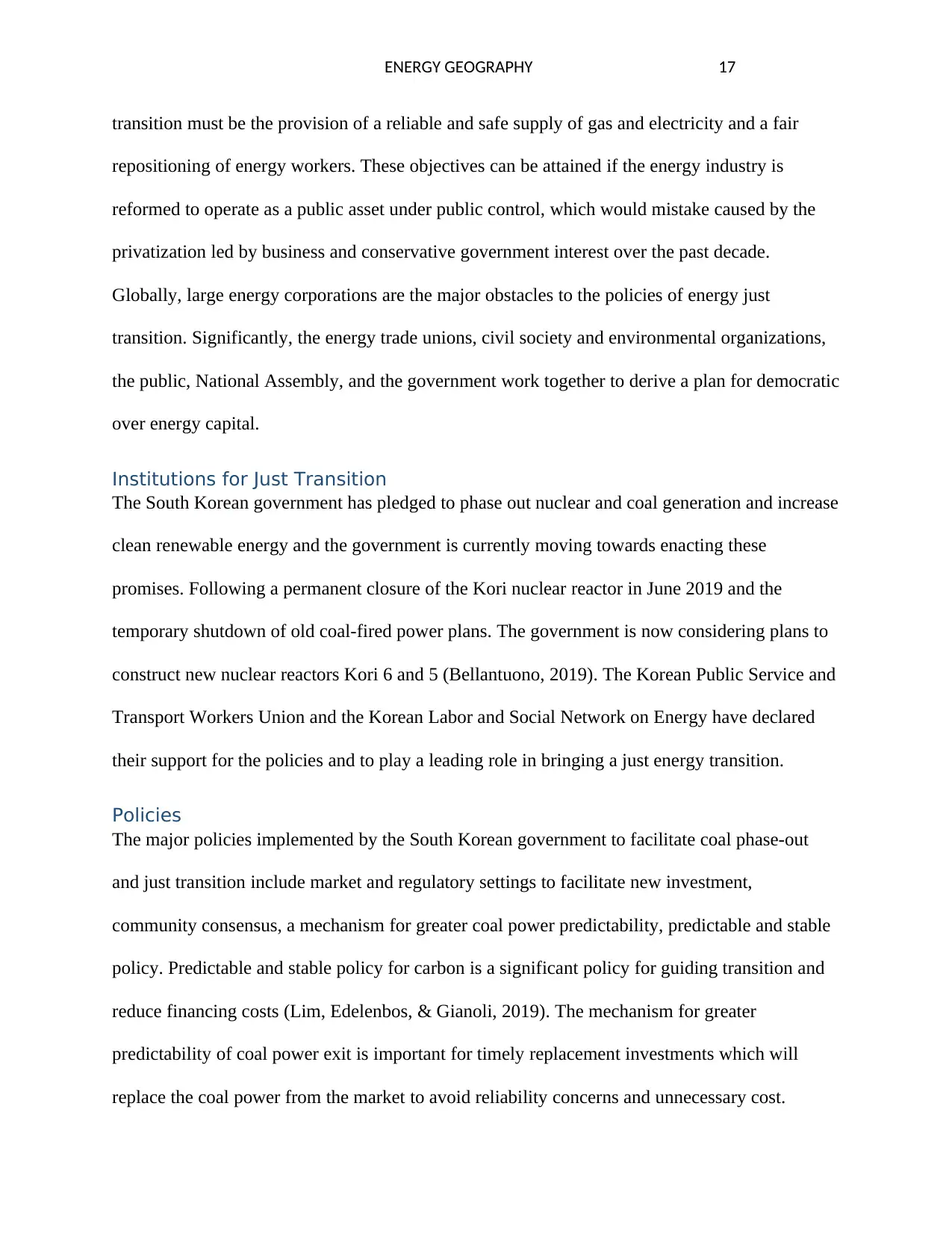
ENERGY GEOGRAPHY 17
transition must be the provision of a reliable and safe supply of gas and electricity and a fair
repositioning of energy workers. These objectives can be attained if the energy industry is
reformed to operate as a public asset under public control, which would mistake caused by the
privatization led by business and conservative government interest over the past decade.
Globally, large energy corporations are the major obstacles to the policies of energy just
transition. Significantly, the energy trade unions, civil society and environmental organizations,
the public, National Assembly, and the government work together to derive a plan for democratic
over energy capital.
Institutions for Just Transition
The South Korean government has pledged to phase out nuclear and coal generation and increase
clean renewable energy and the government is currently moving towards enacting these
promises. Following a permanent closure of the Kori nuclear reactor in June 2019 and the
temporary shutdown of old coal-fired power plans. The government is now considering plans to
construct new nuclear reactors Kori 6 and 5 (Bellantuono, 2019). The Korean Public Service and
Transport Workers Union and the Korean Labor and Social Network on Energy have declared
their support for the policies and to play a leading role in bringing a just energy transition.
Policies
The major policies implemented by the South Korean government to facilitate coal phase-out
and just transition include market and regulatory settings to facilitate new investment,
community consensus, a mechanism for greater coal power predictability, predictable and stable
policy. Predictable and stable policy for carbon is a significant policy for guiding transition and
reduce financing costs (Lim, Edelenbos, & Gianoli, 2019). The mechanism for greater
predictability of coal power exit is important for timely replacement investments which will
replace the coal power from the market to avoid reliability concerns and unnecessary cost.
transition must be the provision of a reliable and safe supply of gas and electricity and a fair
repositioning of energy workers. These objectives can be attained if the energy industry is
reformed to operate as a public asset under public control, which would mistake caused by the
privatization led by business and conservative government interest over the past decade.
Globally, large energy corporations are the major obstacles to the policies of energy just
transition. Significantly, the energy trade unions, civil society and environmental organizations,
the public, National Assembly, and the government work together to derive a plan for democratic
over energy capital.
Institutions for Just Transition
The South Korean government has pledged to phase out nuclear and coal generation and increase
clean renewable energy and the government is currently moving towards enacting these
promises. Following a permanent closure of the Kori nuclear reactor in June 2019 and the
temporary shutdown of old coal-fired power plans. The government is now considering plans to
construct new nuclear reactors Kori 6 and 5 (Bellantuono, 2019). The Korean Public Service and
Transport Workers Union and the Korean Labor and Social Network on Energy have declared
their support for the policies and to play a leading role in bringing a just energy transition.
Policies
The major policies implemented by the South Korean government to facilitate coal phase-out
and just transition include market and regulatory settings to facilitate new investment,
community consensus, a mechanism for greater coal power predictability, predictable and stable
policy. Predictable and stable policy for carbon is a significant policy for guiding transition and
reduce financing costs (Lim, Edelenbos, & Gianoli, 2019). The mechanism for greater
predictability of coal power exit is important for timely replacement investments which will
replace the coal power from the market to avoid reliability concerns and unnecessary cost.
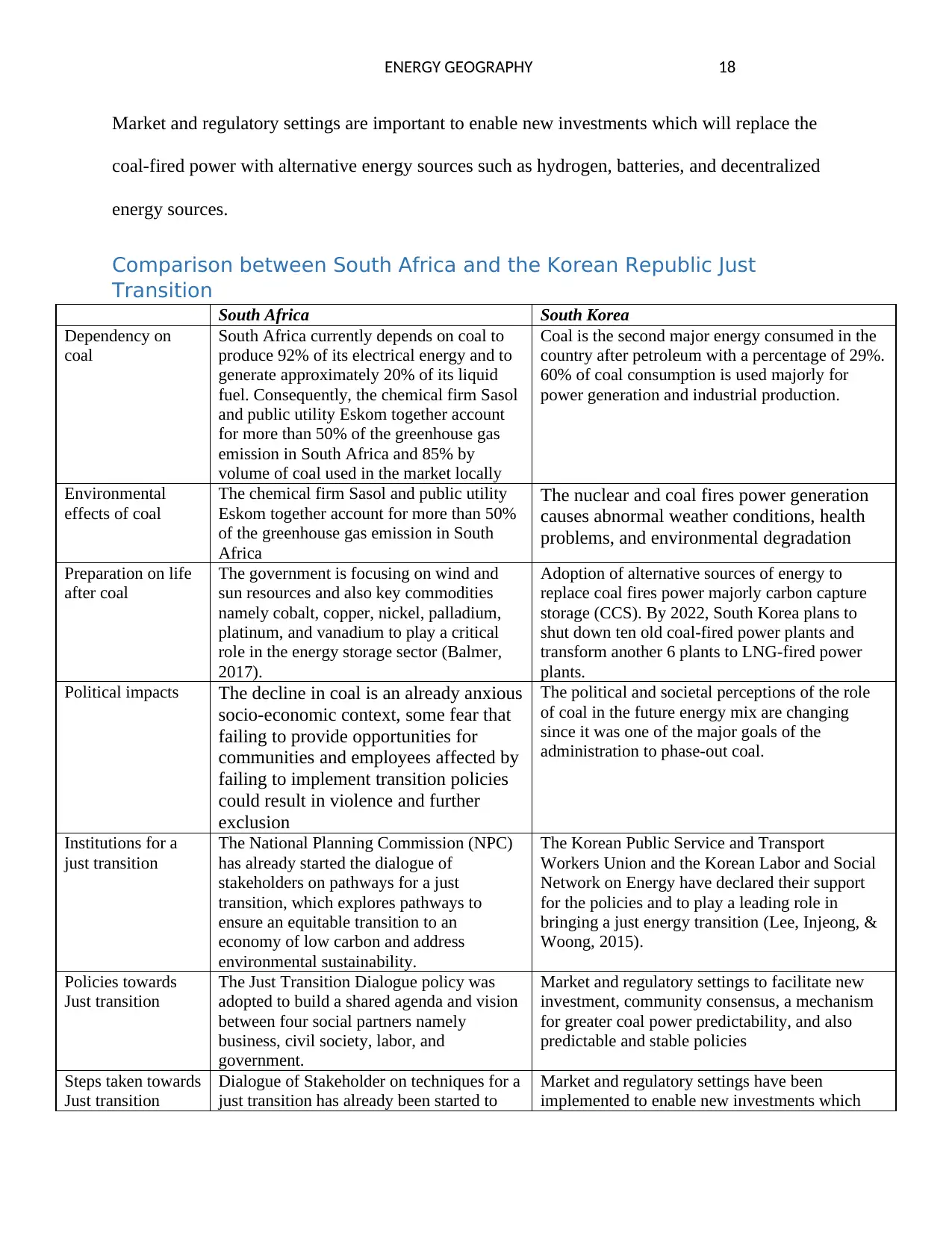
ENERGY GEOGRAPHY 18
Market and regulatory settings are important to enable new investments which will replace the
coal-fired power with alternative energy sources such as hydrogen, batteries, and decentralized
energy sources.
Comparison between South Africa and the Korean Republic Just
Transition
South Africa South Korea
Dependency on
coal
South Africa currently depends on coal to
produce 92% of its electrical energy and to
generate approximately 20% of its liquid
fuel. Consequently, the chemical firm Sasol
and public utility Eskom together account
for more than 50% of the greenhouse gas
emission in South Africa and 85% by
volume of coal used in the market locally
Coal is the second major energy consumed in the
country after petroleum with a percentage of 29%.
60% of coal consumption is used majorly for
power generation and industrial production.
Environmental
effects of coal
The chemical firm Sasol and public utility
Eskom together account for more than 50%
of the greenhouse gas emission in South
Africa
The nuclear and coal fires power generation
causes abnormal weather conditions, health
problems, and environmental degradation
Preparation on life
after coal
The government is focusing on wind and
sun resources and also key commodities
namely cobalt, copper, nickel, palladium,
platinum, and vanadium to play a critical
role in the energy storage sector (Balmer,
2017).
Adoption of alternative sources of energy to
replace coal fires power majorly carbon capture
storage (CCS). By 2022, South Korea plans to
shut down ten old coal-fired power plants and
transform another 6 plants to LNG-fired power
plants.
Political impacts The decline in coal is an already anxious
socio-economic context, some fear that
failing to provide opportunities for
communities and employees affected by
failing to implement transition policies
could result in violence and further
exclusion
The political and societal perceptions of the role
of coal in the future energy mix are changing
since it was one of the major goals of the
administration to phase-out coal.
Institutions for a
just transition
The National Planning Commission (NPC)
has already started the dialogue of
stakeholders on pathways for a just
transition, which explores pathways to
ensure an equitable transition to an
economy of low carbon and address
environmental sustainability.
The Korean Public Service and Transport
Workers Union and the Korean Labor and Social
Network on Energy have declared their support
for the policies and to play a leading role in
bringing a just energy transition (Lee, Injeong, &
Woong, 2015).
Policies towards
Just transition
The Just Transition Dialogue policy was
adopted to build a shared agenda and vision
between four social partners namely
business, civil society, labor, and
government.
Market and regulatory settings to facilitate new
investment, community consensus, a mechanism
for greater coal power predictability, and also
predictable and stable policies
Steps taken towards
Just transition
Dialogue of Stakeholder on techniques for a
just transition has already been started to
Market and regulatory settings have been
implemented to enable new investments which
Market and regulatory settings are important to enable new investments which will replace the
coal-fired power with alternative energy sources such as hydrogen, batteries, and decentralized
energy sources.
Comparison between South Africa and the Korean Republic Just
Transition
South Africa South Korea
Dependency on
coal
South Africa currently depends on coal to
produce 92% of its electrical energy and to
generate approximately 20% of its liquid
fuel. Consequently, the chemical firm Sasol
and public utility Eskom together account
for more than 50% of the greenhouse gas
emission in South Africa and 85% by
volume of coal used in the market locally
Coal is the second major energy consumed in the
country after petroleum with a percentage of 29%.
60% of coal consumption is used majorly for
power generation and industrial production.
Environmental
effects of coal
The chemical firm Sasol and public utility
Eskom together account for more than 50%
of the greenhouse gas emission in South
Africa
The nuclear and coal fires power generation
causes abnormal weather conditions, health
problems, and environmental degradation
Preparation on life
after coal
The government is focusing on wind and
sun resources and also key commodities
namely cobalt, copper, nickel, palladium,
platinum, and vanadium to play a critical
role in the energy storage sector (Balmer,
2017).
Adoption of alternative sources of energy to
replace coal fires power majorly carbon capture
storage (CCS). By 2022, South Korea plans to
shut down ten old coal-fired power plants and
transform another 6 plants to LNG-fired power
plants.
Political impacts The decline in coal is an already anxious
socio-economic context, some fear that
failing to provide opportunities for
communities and employees affected by
failing to implement transition policies
could result in violence and further
exclusion
The political and societal perceptions of the role
of coal in the future energy mix are changing
since it was one of the major goals of the
administration to phase-out coal.
Institutions for a
just transition
The National Planning Commission (NPC)
has already started the dialogue of
stakeholders on pathways for a just
transition, which explores pathways to
ensure an equitable transition to an
economy of low carbon and address
environmental sustainability.
The Korean Public Service and Transport
Workers Union and the Korean Labor and Social
Network on Energy have declared their support
for the policies and to play a leading role in
bringing a just energy transition (Lee, Injeong, &
Woong, 2015).
Policies towards
Just transition
The Just Transition Dialogue policy was
adopted to build a shared agenda and vision
between four social partners namely
business, civil society, labor, and
government.
Market and regulatory settings to facilitate new
investment, community consensus, a mechanism
for greater coal power predictability, and also
predictable and stable policies
Steps taken towards
Just transition
Dialogue of Stakeholder on techniques for a
just transition has already been started to
Market and regulatory settings have been
implemented to enable new investments which
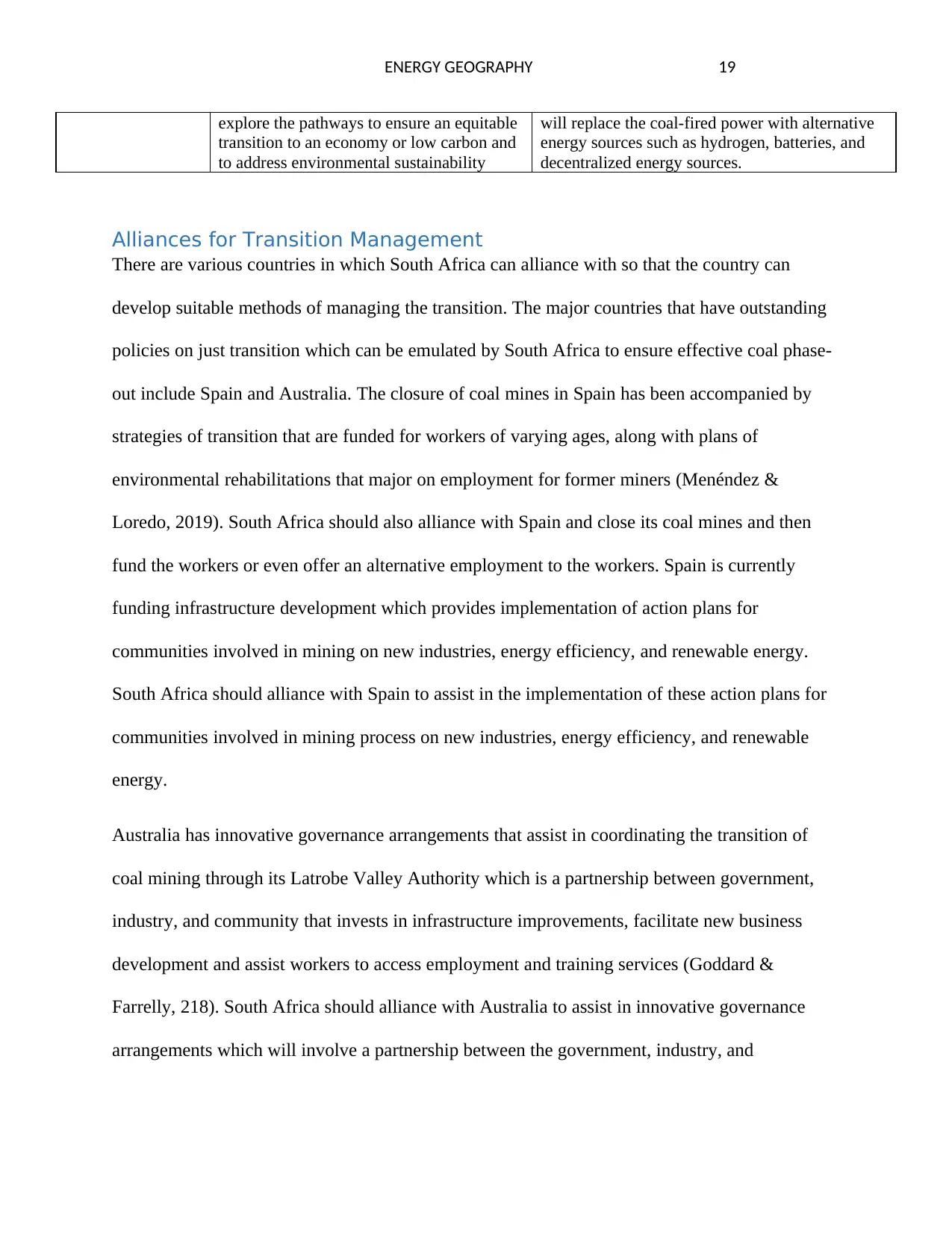
ENERGY GEOGRAPHY 19
explore the pathways to ensure an equitable
transition to an economy or low carbon and
to address environmental sustainability
will replace the coal-fired power with alternative
energy sources such as hydrogen, batteries, and
decentralized energy sources.
Alliances for Transition Management
There are various countries in which South Africa can alliance with so that the country can
develop suitable methods of managing the transition. The major countries that have outstanding
policies on just transition which can be emulated by South Africa to ensure effective coal phase-
out include Spain and Australia. The closure of coal mines in Spain has been accompanied by
strategies of transition that are funded for workers of varying ages, along with plans of
environmental rehabilitations that major on employment for former miners (Menéndez &
Loredo, 2019). South Africa should also alliance with Spain and close its coal mines and then
fund the workers or even offer an alternative employment to the workers. Spain is currently
funding infrastructure development which provides implementation of action plans for
communities involved in mining on new industries, energy efficiency, and renewable energy.
South Africa should alliance with Spain to assist in the implementation of these action plans for
communities involved in mining process on new industries, energy efficiency, and renewable
energy.
Australia has innovative governance arrangements that assist in coordinating the transition of
coal mining through its Latrobe Valley Authority which is a partnership between government,
industry, and community that invests in infrastructure improvements, facilitate new business
development and assist workers to access employment and training services (Goddard &
Farrelly, 218). South Africa should alliance with Australia to assist in innovative governance
arrangements which will involve a partnership between the government, industry, and
explore the pathways to ensure an equitable
transition to an economy or low carbon and
to address environmental sustainability
will replace the coal-fired power with alternative
energy sources such as hydrogen, batteries, and
decentralized energy sources.
Alliances for Transition Management
There are various countries in which South Africa can alliance with so that the country can
develop suitable methods of managing the transition. The major countries that have outstanding
policies on just transition which can be emulated by South Africa to ensure effective coal phase-
out include Spain and Australia. The closure of coal mines in Spain has been accompanied by
strategies of transition that are funded for workers of varying ages, along with plans of
environmental rehabilitations that major on employment for former miners (Menéndez &
Loredo, 2019). South Africa should also alliance with Spain and close its coal mines and then
fund the workers or even offer an alternative employment to the workers. Spain is currently
funding infrastructure development which provides implementation of action plans for
communities involved in mining on new industries, energy efficiency, and renewable energy.
South Africa should alliance with Spain to assist in the implementation of these action plans for
communities involved in mining process on new industries, energy efficiency, and renewable
energy.
Australia has innovative governance arrangements that assist in coordinating the transition of
coal mining through its Latrobe Valley Authority which is a partnership between government,
industry, and community that invests in infrastructure improvements, facilitate new business
development and assist workers to access employment and training services (Goddard &
Farrelly, 218). South Africa should alliance with Australia to assist in innovative governance
arrangements which will involve a partnership between the government, industry, and
Paraphrase This Document
Need a fresh take? Get an instant paraphrase of this document with our AI Paraphraser
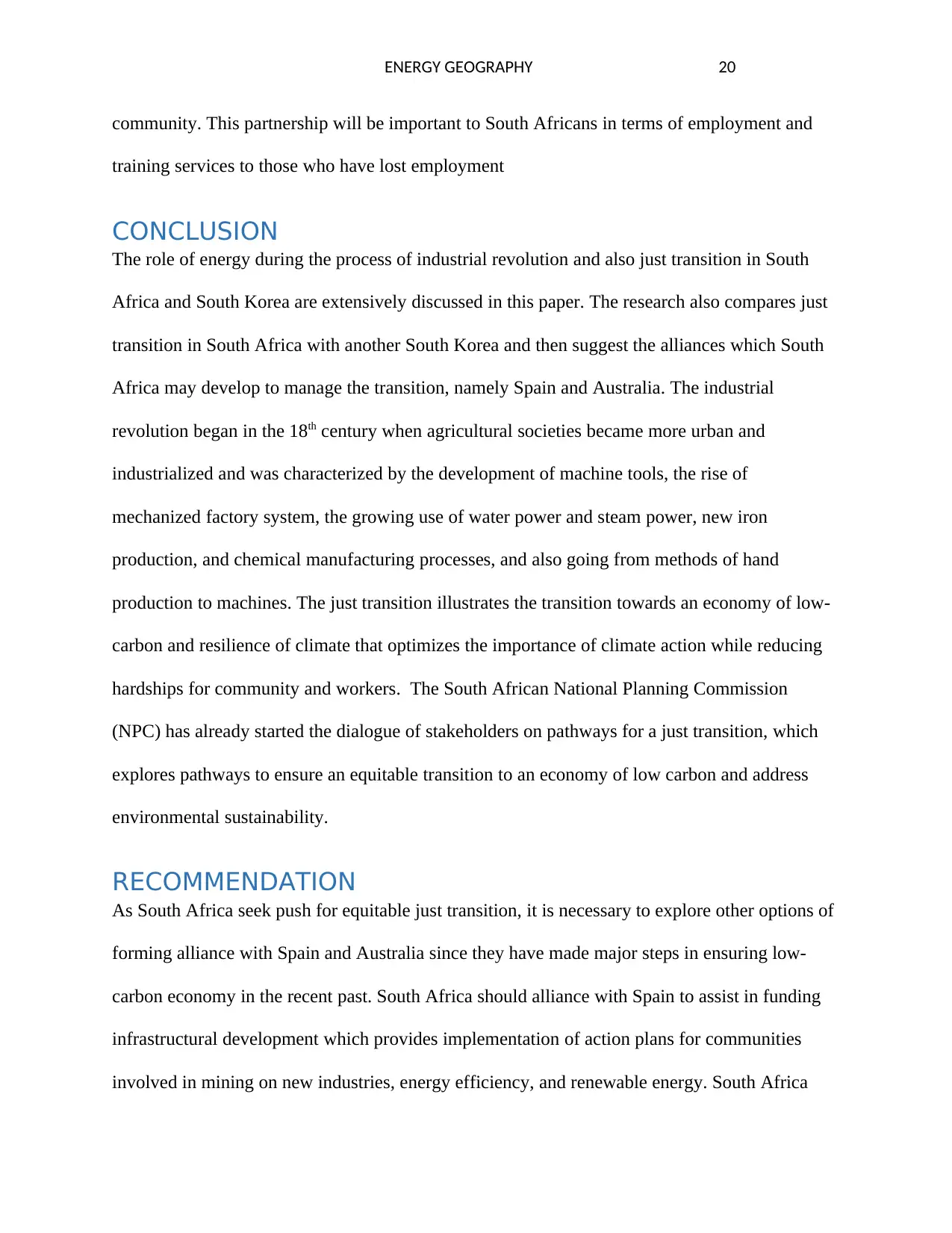
ENERGY GEOGRAPHY 20
community. This partnership will be important to South Africans in terms of employment and
training services to those who have lost employment
CONCLUSION
The role of energy during the process of industrial revolution and also just transition in South
Africa and South Korea are extensively discussed in this paper. The research also compares just
transition in South Africa with another South Korea and then suggest the alliances which South
Africa may develop to manage the transition, namely Spain and Australia. The industrial
revolution began in the 18th century when agricultural societies became more urban and
industrialized and was characterized by the development of machine tools, the rise of
mechanized factory system, the growing use of water power and steam power, new iron
production, and chemical manufacturing processes, and also going from methods of hand
production to machines. The just transition illustrates the transition towards an economy of low-
carbon and resilience of climate that optimizes the importance of climate action while reducing
hardships for community and workers. The South African National Planning Commission
(NPC) has already started the dialogue of stakeholders on pathways for a just transition, which
explores pathways to ensure an equitable transition to an economy of low carbon and address
environmental sustainability.
RECOMMENDATION
As South Africa seek push for equitable just transition, it is necessary to explore other options of
forming alliance with Spain and Australia since they have made major steps in ensuring low-
carbon economy in the recent past. South Africa should alliance with Spain to assist in funding
infrastructural development which provides implementation of action plans for communities
involved in mining on new industries, energy efficiency, and renewable energy. South Africa
community. This partnership will be important to South Africans in terms of employment and
training services to those who have lost employment
CONCLUSION
The role of energy during the process of industrial revolution and also just transition in South
Africa and South Korea are extensively discussed in this paper. The research also compares just
transition in South Africa with another South Korea and then suggest the alliances which South
Africa may develop to manage the transition, namely Spain and Australia. The industrial
revolution began in the 18th century when agricultural societies became more urban and
industrialized and was characterized by the development of machine tools, the rise of
mechanized factory system, the growing use of water power and steam power, new iron
production, and chemical manufacturing processes, and also going from methods of hand
production to machines. The just transition illustrates the transition towards an economy of low-
carbon and resilience of climate that optimizes the importance of climate action while reducing
hardships for community and workers. The South African National Planning Commission
(NPC) has already started the dialogue of stakeholders on pathways for a just transition, which
explores pathways to ensure an equitable transition to an economy of low carbon and address
environmental sustainability.
RECOMMENDATION
As South Africa seek push for equitable just transition, it is necessary to explore other options of
forming alliance with Spain and Australia since they have made major steps in ensuring low-
carbon economy in the recent past. South Africa should alliance with Spain to assist in funding
infrastructural development which provides implementation of action plans for communities
involved in mining on new industries, energy efficiency, and renewable energy. South Africa
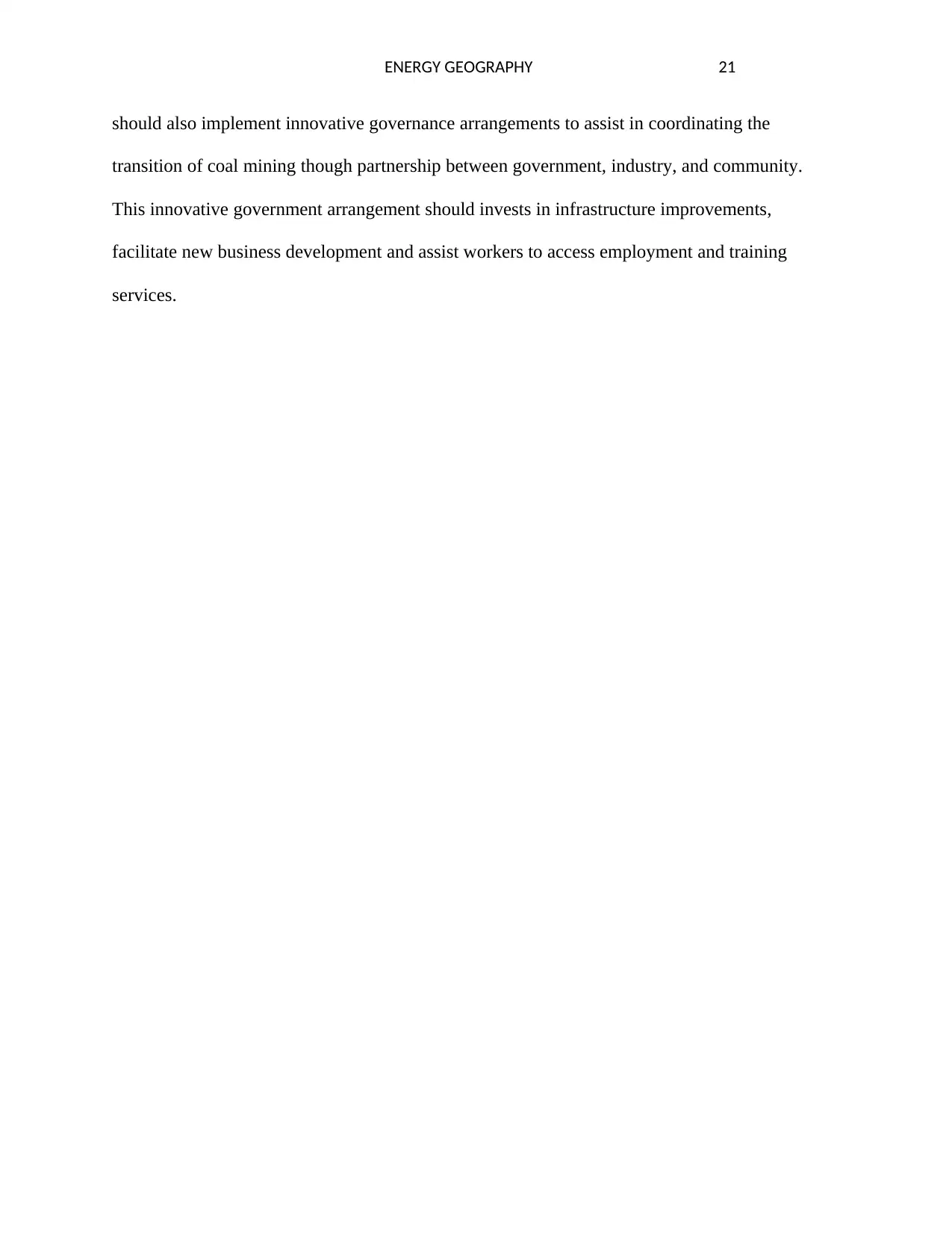
ENERGY GEOGRAPHY 21
should also implement innovative governance arrangements to assist in coordinating the
transition of coal mining though partnership between government, industry, and community.
This innovative government arrangement should invests in infrastructure improvements,
facilitate new business development and assist workers to access employment and training
services.
should also implement innovative governance arrangements to assist in coordinating the
transition of coal mining though partnership between government, industry, and community.
This innovative government arrangement should invests in infrastructure improvements,
facilitate new business development and assist workers to access employment and training
services.
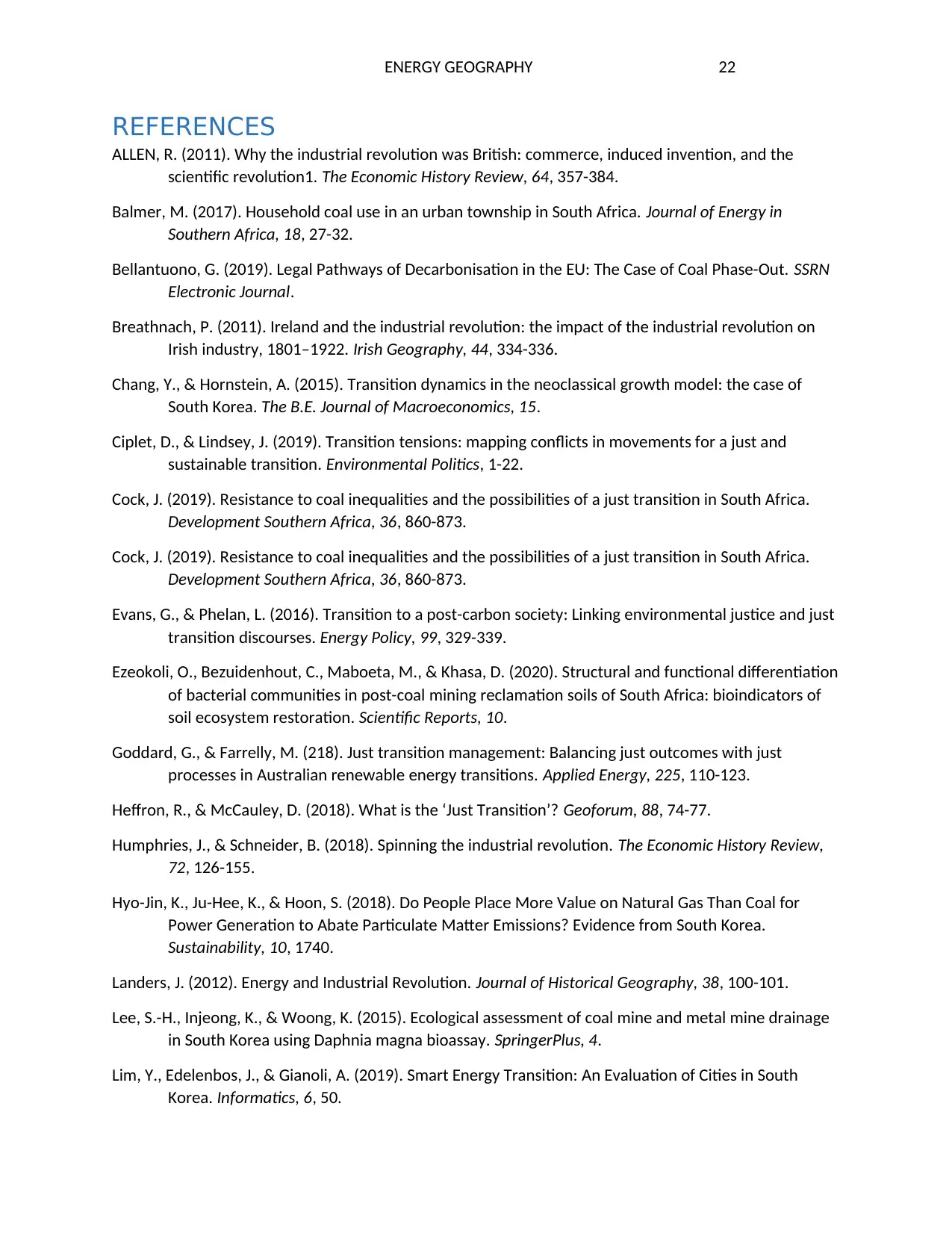
ENERGY GEOGRAPHY 22
REFERENCES
ALLEN, R. (2011). Why the industrial revolution was British: commerce, induced invention, and the
scientific revolution1. The Economic History Review, 64, 357-384.
Balmer, M. (2017). Household coal use in an urban township in South Africa. Journal of Energy in
Southern Africa, 18, 27-32.
Bellantuono, G. (2019). Legal Pathways of Decarbonisation in the EU: The Case of Coal Phase-Out. SSRN
Electronic Journal.
Breathnach, P. (2011). Ireland and the industrial revolution: the impact of the industrial revolution on
Irish industry, 1801–1922. Irish Geography, 44, 334-336.
Chang, Y., & Hornstein, A. (2015). Transition dynamics in the neoclassical growth model: the case of
South Korea. The B.E. Journal of Macroeconomics, 15.
Ciplet, D., & Lindsey, J. (2019). Transition tensions: mapping conflicts in movements for a just and
sustainable transition. Environmental Politics, 1-22.
Cock, J. (2019). Resistance to coal inequalities and the possibilities of a just transition in South Africa.
Development Southern Africa, 36, 860-873.
Cock, J. (2019). Resistance to coal inequalities and the possibilities of a just transition in South Africa.
Development Southern Africa, 36, 860-873.
Evans, G., & Phelan, L. (2016). Transition to a post-carbon society: Linking environmental justice and just
transition discourses. Energy Policy, 99, 329-339.
Ezeokoli, O., Bezuidenhout, C., Maboeta, M., & Khasa, D. (2020). Structural and functional differentiation
of bacterial communities in post-coal mining reclamation soils of South Africa: bioindicators of
soil ecosystem restoration. Scientific Reports, 10.
Goddard, G., & Farrelly, M. (218). Just transition management: Balancing just outcomes with just
processes in Australian renewable energy transitions. Applied Energy, 225, 110-123.
Heffron, R., & McCauley, D. (2018). What is the ‘Just Transition’? Geoforum, 88, 74-77.
Humphries, J., & Schneider, B. (2018). Spinning the industrial revolution. The Economic History Review,
72, 126-155.
Hyo-Jin, K., Ju-Hee, K., & Hoon, S. (2018). Do People Place More Value on Natural Gas Than Coal for
Power Generation to Abate Particulate Matter Emissions? Evidence from South Korea.
Sustainability, 10, 1740.
Landers, J. (2012). Energy and Industrial Revolution. Journal of Historical Geography, 38, 100-101.
Lee, S.-H., Injeong, K., & Woong, K. (2015). Ecological assessment of coal mine and metal mine drainage
in South Korea using Daphnia magna bioassay. SpringerPlus, 4.
Lim, Y., Edelenbos, J., & Gianoli, A. (2019). Smart Energy Transition: An Evaluation of Cities in South
Korea. Informatics, 6, 50.
REFERENCES
ALLEN, R. (2011). Why the industrial revolution was British: commerce, induced invention, and the
scientific revolution1. The Economic History Review, 64, 357-384.
Balmer, M. (2017). Household coal use in an urban township in South Africa. Journal of Energy in
Southern Africa, 18, 27-32.
Bellantuono, G. (2019). Legal Pathways of Decarbonisation in the EU: The Case of Coal Phase-Out. SSRN
Electronic Journal.
Breathnach, P. (2011). Ireland and the industrial revolution: the impact of the industrial revolution on
Irish industry, 1801–1922. Irish Geography, 44, 334-336.
Chang, Y., & Hornstein, A. (2015). Transition dynamics in the neoclassical growth model: the case of
South Korea. The B.E. Journal of Macroeconomics, 15.
Ciplet, D., & Lindsey, J. (2019). Transition tensions: mapping conflicts in movements for a just and
sustainable transition. Environmental Politics, 1-22.
Cock, J. (2019). Resistance to coal inequalities and the possibilities of a just transition in South Africa.
Development Southern Africa, 36, 860-873.
Cock, J. (2019). Resistance to coal inequalities and the possibilities of a just transition in South Africa.
Development Southern Africa, 36, 860-873.
Evans, G., & Phelan, L. (2016). Transition to a post-carbon society: Linking environmental justice and just
transition discourses. Energy Policy, 99, 329-339.
Ezeokoli, O., Bezuidenhout, C., Maboeta, M., & Khasa, D. (2020). Structural and functional differentiation
of bacterial communities in post-coal mining reclamation soils of South Africa: bioindicators of
soil ecosystem restoration. Scientific Reports, 10.
Goddard, G., & Farrelly, M. (218). Just transition management: Balancing just outcomes with just
processes in Australian renewable energy transitions. Applied Energy, 225, 110-123.
Heffron, R., & McCauley, D. (2018). What is the ‘Just Transition’? Geoforum, 88, 74-77.
Humphries, J., & Schneider, B. (2018). Spinning the industrial revolution. The Economic History Review,
72, 126-155.
Hyo-Jin, K., Ju-Hee, K., & Hoon, S. (2018). Do People Place More Value on Natural Gas Than Coal for
Power Generation to Abate Particulate Matter Emissions? Evidence from South Korea.
Sustainability, 10, 1740.
Landers, J. (2012). Energy and Industrial Revolution. Journal of Historical Geography, 38, 100-101.
Lee, S.-H., Injeong, K., & Woong, K. (2015). Ecological assessment of coal mine and metal mine drainage
in South Korea using Daphnia magna bioassay. SpringerPlus, 4.
Lim, Y., Edelenbos, J., & Gianoli, A. (2019). Smart Energy Transition: An Evaluation of Cities in South
Korea. Informatics, 6, 50.
Secure Best Marks with AI Grader
Need help grading? Try our AI Grader for instant feedback on your assignments.
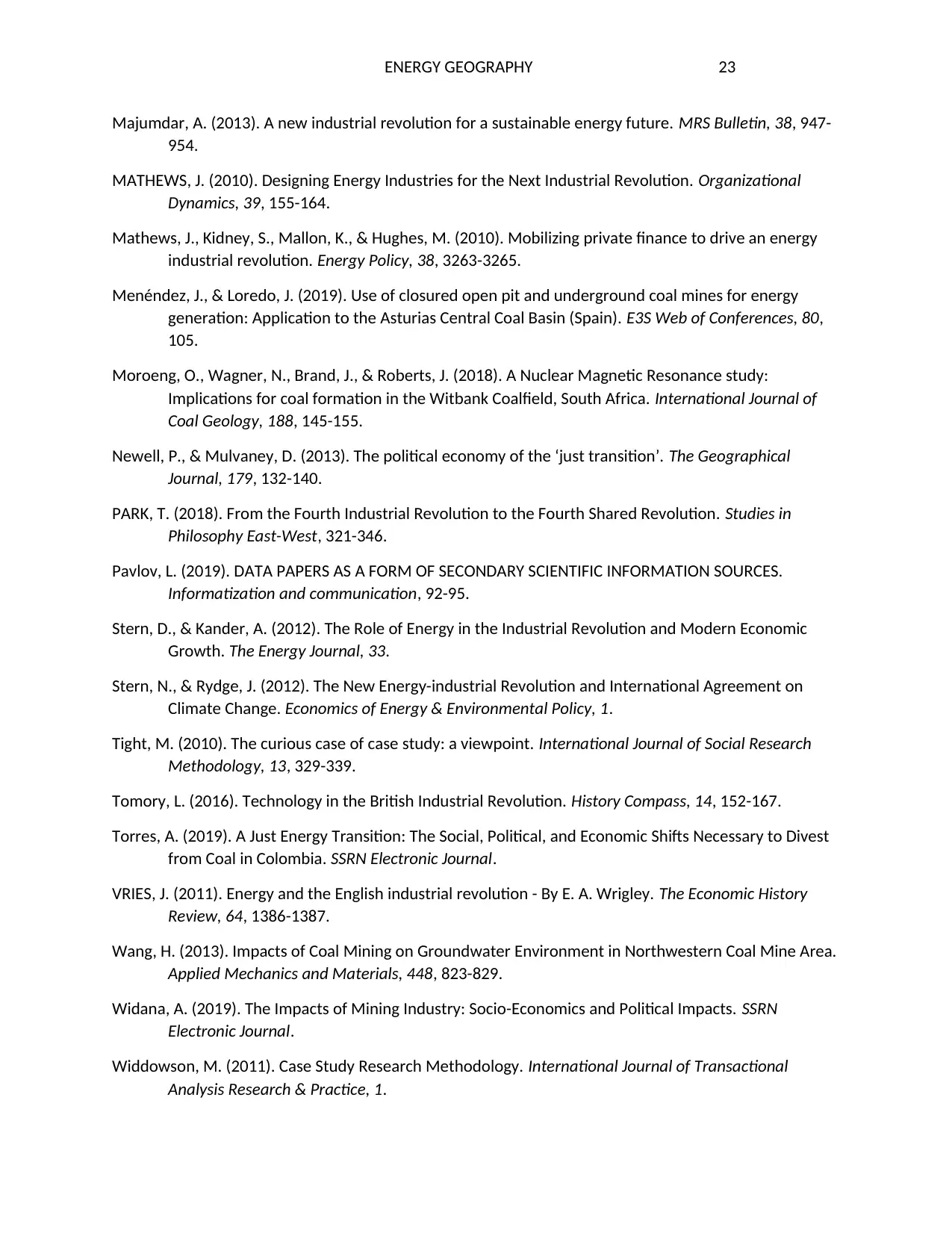
ENERGY GEOGRAPHY 23
Majumdar, A. (2013). A new industrial revolution for a sustainable energy future. MRS Bulletin, 38, 947-
954.
MATHEWS, J. (2010). Designing Energy Industries for the Next Industrial Revolution. Organizational
Dynamics, 39, 155-164.
Mathews, J., Kidney, S., Mallon, K., & Hughes, M. (2010). Mobilizing private finance to drive an energy
industrial revolution. Energy Policy, 38, 3263-3265.
Menéndez, J., & Loredo, J. (2019). Use of closured open pit and underground coal mines for energy
generation: Application to the Asturias Central Coal Basin (Spain). E3S Web of Conferences, 80,
105.
Moroeng, O., Wagner, N., Brand, J., & Roberts, J. (2018). A Nuclear Magnetic Resonance study:
Implications for coal formation in the Witbank Coalfield, South Africa. International Journal of
Coal Geology, 188, 145-155.
Newell, P., & Mulvaney, D. (2013). The political economy of the ‘just transition’. The Geographical
Journal, 179, 132-140.
PARK, T. (2018). From the Fourth Industrial Revolution to the Fourth Shared Revolution. Studies in
Philosophy East-West, 321-346.
Pavlov, L. (2019). DATA PAPERS AS A FORM OF SECONDARY SCIENTIFIC INFORMATION SOURCES.
Informatization and communication, 92-95.
Stern, D., & Kander, A. (2012). The Role of Energy in the Industrial Revolution and Modern Economic
Growth. The Energy Journal, 33.
Stern, N., & Rydge, J. (2012). The New Energy-industrial Revolution and International Agreement on
Climate Change. Economics of Energy & Environmental Policy, 1.
Tight, M. (2010). The curious case of case study: a viewpoint. International Journal of Social Research
Methodology, 13, 329-339.
Tomory, L. (2016). Technology in the British Industrial Revolution. History Compass, 14, 152-167.
Torres, A. (2019). A Just Energy Transition: The Social, Political, and Economic Shifts Necessary to Divest
from Coal in Colombia. SSRN Electronic Journal.
VRIES, J. (2011). Energy and the English industrial revolution - By E. A. Wrigley. The Economic History
Review, 64, 1386-1387.
Wang, H. (2013). Impacts of Coal Mining on Groundwater Environment in Northwestern Coal Mine Area.
Applied Mechanics and Materials, 448, 823-829.
Widana, A. (2019). The Impacts of Mining Industry: Socio-Economics and Political Impacts. SSRN
Electronic Journal.
Widdowson, M. (2011). Case Study Research Methodology. International Journal of Transactional
Analysis Research & Practice, 1.
Majumdar, A. (2013). A new industrial revolution for a sustainable energy future. MRS Bulletin, 38, 947-
954.
MATHEWS, J. (2010). Designing Energy Industries for the Next Industrial Revolution. Organizational
Dynamics, 39, 155-164.
Mathews, J., Kidney, S., Mallon, K., & Hughes, M. (2010). Mobilizing private finance to drive an energy
industrial revolution. Energy Policy, 38, 3263-3265.
Menéndez, J., & Loredo, J. (2019). Use of closured open pit and underground coal mines for energy
generation: Application to the Asturias Central Coal Basin (Spain). E3S Web of Conferences, 80,
105.
Moroeng, O., Wagner, N., Brand, J., & Roberts, J. (2018). A Nuclear Magnetic Resonance study:
Implications for coal formation in the Witbank Coalfield, South Africa. International Journal of
Coal Geology, 188, 145-155.
Newell, P., & Mulvaney, D. (2013). The political economy of the ‘just transition’. The Geographical
Journal, 179, 132-140.
PARK, T. (2018). From the Fourth Industrial Revolution to the Fourth Shared Revolution. Studies in
Philosophy East-West, 321-346.
Pavlov, L. (2019). DATA PAPERS AS A FORM OF SECONDARY SCIENTIFIC INFORMATION SOURCES.
Informatization and communication, 92-95.
Stern, D., & Kander, A. (2012). The Role of Energy in the Industrial Revolution and Modern Economic
Growth. The Energy Journal, 33.
Stern, N., & Rydge, J. (2012). The New Energy-industrial Revolution and International Agreement on
Climate Change. Economics of Energy & Environmental Policy, 1.
Tight, M. (2010). The curious case of case study: a viewpoint. International Journal of Social Research
Methodology, 13, 329-339.
Tomory, L. (2016). Technology in the British Industrial Revolution. History Compass, 14, 152-167.
Torres, A. (2019). A Just Energy Transition: The Social, Political, and Economic Shifts Necessary to Divest
from Coal in Colombia. SSRN Electronic Journal.
VRIES, J. (2011). Energy and the English industrial revolution - By E. A. Wrigley. The Economic History
Review, 64, 1386-1387.
Wang, H. (2013). Impacts of Coal Mining on Groundwater Environment in Northwestern Coal Mine Area.
Applied Mechanics and Materials, 448, 823-829.
Widana, A. (2019). The Impacts of Mining Industry: Socio-Economics and Political Impacts. SSRN
Electronic Journal.
Widdowson, M. (2011). Case Study Research Methodology. International Journal of Transactional
Analysis Research & Practice, 1.

ENERGY GEOGRAPHY 24
Zadek, S. (2018). Financing a Just Transition. Organization & Environment, 32, 18-25.
Zhavoronkova, N., & Shpakovskiy, G. (2019). Environmental and Energy Problems of the 4th Industrial
Revolution: Legal Aspects. Lex Russica(10), 53-62.
Zieleniewski, M., & Brent, C. (2017). Evaluating the costs and achievable benefits of extending
technologies for uneconomical coal resources in South Africa: the case of underground coal
gasification. Journal of Energy in Southern Africa, 19, 21-31.
Zadek, S. (2018). Financing a Just Transition. Organization & Environment, 32, 18-25.
Zhavoronkova, N., & Shpakovskiy, G. (2019). Environmental and Energy Problems of the 4th Industrial
Revolution: Legal Aspects. Lex Russica(10), 53-62.
Zieleniewski, M., & Brent, C. (2017). Evaluating the costs and achievable benefits of extending
technologies for uneconomical coal resources in South Africa: the case of underground coal
gasification. Journal of Energy in Southern Africa, 19, 21-31.
1 out of 24
Related Documents
Your All-in-One AI-Powered Toolkit for Academic Success.
+13062052269
info@desklib.com
Available 24*7 on WhatsApp / Email
![[object Object]](/_next/static/media/star-bottom.7253800d.svg)
Unlock your academic potential
© 2024 | Zucol Services PVT LTD | All rights reserved.



![[SOLVED] Energy Efficiency and Sustainability Analysis](/_next/image/?url=https%3A%2F%2Fdesklib.com%2Fmedia%2Fimages%2Fzg%2F45fdf0b214554a6a9b1959c90cde81a6.jpg&w=256&q=75)
